Page 1

DCR 6024 / 6128 / 6000
MEDIA RECORDER
Bild im Format 16:9
Planning & Installation Manual
Page 2

BTS Media Solutions GmbH
Brunnenweg 9
D-64331 Weiterstadt, Germany
P.O. Box 1 165
Tel: +49 (0) 6155-870-0
Fax: +49 (0) 6155-870-300
Für diese Unterlage behalten wir uns alle
Rechte vor (Gemäß DIN 34).
Technische Änderungen im Zuge der
Weiterentwicklung vorbehalten.
Copying of this document and giving it to
others, and the use or communication of
the contents thereof, are forbidden without
expressed authority. Of fenders are liable to
the payment of damages. All rights are reserved in the event of the grant of a patent
or the registration of a utility model or design.
Liable to technical alterations in the course
of further development.
Toute communication ou reproduction de
ce document, toute exploitation ou communication de son contenu sont interdites,
sauf autorisation expressé. T out manquement à cette règle est illicite et expose son
auteur au versement de dommages et
intérêts. Tous nos droits sont réservés
pour le cas de la délivrance d’un brevet ou
de l’enregistrement d’un modèle d’utilité.
Sous réserve de modification au cours de
l’évolution technique.
BTS Media Solutions GmbH 2001
Copyrights
Published by
Page 3

ContentsDCR 6024/6128/6000
I
Planning & Installation – Rev. 1 / 7. 2001
CONTENTS
Page
Safaty Instructions
1. General 1 – 1
1.1 Features 1 – 1
1.2 Overview 1 – 3
1.3 Mechanical design 1 – 6
1.4 Machine control 1 – 7
1.5 Blockdiagram 1 – 9
1.6 Functional overview 1 – 13
1.6.1 D–6 Standard 1 – 13
1.6.2 DTV Processor DTV 6024 1 – 17
1.6.3 Data Processor DDP 6128 1 – 20
1.6.4 Tape Deck DMS 6000 1 – 22
1.6.5 Scanner Assemply 1 – 28
1.6.6 Control Panel DCH 6024 CP 1 – 30
1.6.7 Data Switch DSW 6000 1 – 31
2. Technical Specifications 2 – 1
2.1 General 2 – 1
2.2 Tape Deck / Recording System 2 – 2
2.3 DTV System 2 – 4
2.3.1 Video 2 – 4
2.3.2 Audio 2 – 6
2.3.3 Cue Audio 2 – 7
2.3.4 Control 2 – 7
2.4 Data System 2 – 8
2.4.1 Data Input / Output 2 – 8
2.4.2 DPX Monitoring 2 – 8
2.4.3 Control 2 – 8
2.5 Inputs / Outputs 2 – 9
2.5.1 Tape Deck DMS 6000 2 – 9
2.5.2 DTV Processor DTV 6024 2 – 10
2.5.3 Data Processor DDP 6128 2 – 1 1
2.5.4 Data Switch DSW 6000 2 – 1 1
Page 4

Contents
DCR 6024/6128/6000
II
Planning & Installation – Rev. 1 / 7. 2001
3. Installation 3 – 1
3.1 Unpacking and repacking 3 – 1
3.2 Mechanical dimensions 3 – 2
3.3 Ventilation 3 – 5
3.4 Mounting 3 – 8
3.4.1 Mounting Tapedeck on Processor 3 – 8
3.4.2 Mounting Tapedeck and Processor side by side 3 – 10
3.4.3 Mounting Versions of DCR 6000 3 – 11
3.4.4 Mounting into a 19-inch cabinet 3 – 13
3.4.4.1 Safety Hazards 3 – 13
3.4.4.2 DCR 6024 built in into a19 inch cabinet 3 – 14
3.4.5 Installing Control Panel as Remote Panel 3 – 15
3.4.6 Installing Control Panel as Local Panel 3 – 16
3.5 Standard connections DCR 6024 3 – 17
3.5.1 Connect the connection cables 3 – 18
3.6 Standard connections DCR 6128 3 – 20
3.6.1 Connect the connection cables 3 – 21
3.7 Standard connections DCR 6000 3 – 23
3.7.1 Connect the connection cables 3 – 24
4. Connections 4 – 1
4.1 Rear View DMS 6000 4 – 1
4.2 Rear View DTV 6024 4 – 2
4.3 Rear View DDP 6128 4 – 3
4.4 Rear View DMS 6000 4 – 4
4.5 Terminal Panel – T apedeck DMS 6000 4 – 5
4.5.1 AC power terminal unit BD 5146 4 – 7
4.5.1.1 Grounding 4 – 7
4.5.1.2 Mains connection 4 – 10
4.5.2 Processor Interface 4 – 11
4.5.3 Timecode IN/OUT (DTV Mode) 4 – 12
4.5.4 iMCS 4 – 13
4.5.5 Remote Control REM 1, REM 2, REM 3, RS 232C 4 – 14
4.5.6 Waveform Monitoring 4 – 15
4.5.7 Connection Control Panel and headphone with
volume adjustment 4 – 16
4.6 Terminal Panel – Processor DTV 6024 4 – 17
4.6.1 AC power terminal 4 – 19
4.6.1.1 Grounding 4 – 19
4.6.1.2 Mains connection 4 – 20
4.6.2 Tapedeck Interface 4 – 21
4.6.3 Video Analog Monitor Out 4 – 22
4.6.4 Audio Digital In/Out 4 – 23
4.6.5 Audio Monitoring 4 – 24
4.6.6 Audio Sync (48 kHz) 4 – 25
4.6.7 SDTV / NTSC Sync Out 4 – 25
4.6.8 Playback Ref Sync 4 – 25
4.6.9 iMCS 4 – 26
Page 5

ContentsDCR 6024/6128/6000
III
Planning & Installation – Rev . 1 / 7. 2001
4.7 Terminal Panel – Processor DDP 6128 4 – 27
4.7.1 AC power terminal 4 – 29
4.7.1.1 Grounding 4 – 29
4.7.1.2 Mains connection 4 – 30
4.7.2 Tapedeck Interface 4 – 31
4.7.3 DPX Monitor Out (Option) 4 – 32
4.7.4 HIPPI In/Out 4 – 33
4.7.5 Network Interface 4 – 33
4.7.6 IMCS 4 – 34
5. Startup 5 – 1
5.1 Installation check 5 – 1
5.2 Switching on 5 – 2
5.2.1 Selecting the HD Standard / Data Mode 5 – 4
5.3 Selecting Machine Address 5 – 5
5.4 Control of the Input / Reference signal 5 – 6
5.4.1 DTV Mode 5 – 6
5.4.2 Data Mode 5 – 7
5.5 Operation 5 – 8
6. Interfaces 6 – 1
6.1 RS422 ES - Bus
REM 1 ES-Bus Port according to EBU-Tech 3245-E 6 – 1
6.2 REM 2 IN - RS422A Interface BBE 6 – 6
6.3 REM 2 OUT – RS422A Interface BBE 6 – 15
7. DTV Applications 7 – 1
7.1 List of external devices able to control DCR 6024 7 – 1
7.1.1 VTR editors 7 – 1
7.1.2 Telecine controllers 7 – 1
7.2 Operation under control of Editing- and Graphic Systems 7 – 2
7.3 Parameter Sheets BBE 900 7 – 3
7.4 Parameter Sheets BVE 9000 7 – 4
7.5 More Parameter Sheets (in preparation) 7 – 5
8. Data Applications 8 – 1
8.1. Specter / Transfer Engine / Mover (in preparation) 3-3
9. Index 9 – 1
Page 6

LISTED
PROFESSIONAL VIDEO EQUIPMENT
3S13 / 78MA
U
L
®
LISTED
UL 1950
3S13 / 78MA
U
L
®
Safety InstructionsDCR 6024/6128/6000DCR 6024/6128/6000
I
Planning & Installation – Rev . 1 / 7. 2001
SAFETY INSTRUCTIONS
The DCR 6024/6128/6000 is a digital HDCassette Recorder System designed for
recording and playback of video / audio and / or data signals for various DTV– and
data standards, according to the SMPTE / D-6 HD-recording format.
The DCR 6024/6128/6000 consists of basic modules:
Tapedeck DMS 6000
incl. Control Panel DCH 6024 CP
DTV Processor DTV 6024
Data Processor DDP 6128
Data Switch DSW 6000
To ensure safe operation please observe the following directions:
The current and voltages present in this equipment are dangerous. All personnel must at all times follow the safety regulations.
Always disconnect power before removing covers or panels. Always discharge high voltage points before servicing.
Never make internal adjustments, perform maintenance or service when
alone or fatigued.
In case of an emergency ensure that the power is disconnected.
Any interruption of the protection conductor inside or outside the apparatus,
or disconnection of the protective earth terminal, is likely to make this apparatus dangerous. Intentional interruption is prohibited.
The DCR 6024/6128/6000 VooDoo Media Recorder is designed accordingly to
regulations of the Underwriters Laboratories Inc. Northbrook, Illinois US, certificated and registered under file no.:
E184475 (Tapedeck) /
E205276 (DTV Processor)
E159262 (Data Processor)
E159262 (Data Switch)
Conform with the following European directives and CE marked:
Safety: Low voltage directive 73/23/EEC, EN 60 950/1997
EMC / EMI: EMC directive 89/336/EEC,
EN 55103-1/1996,
EN 55103-2/1996
EN 55022/1998
Electromagnetic environment (acc. to EN 55103–1) E4
Warning:
This is a class A product. In a domestic environment this product may
cause radio interference in which
case the user may be required to take
adequate measures.
Warnung:
Dies ist eine Einrichtung der Klasse
A. Diese Einrichtung kann im
Wohnbereich Funkstörungen
verursachen; in diesem Fall kann vom
Betreiber verlangt werden,
angemessenen Massnahmen
durchzuführen.
Application
Warnings!
Page 7

Safety Instructions DCR 6024/6128/6000
II
Planning & Installation – Rev . 1 / 7. 2001
EMC: AS/NZS 3548
This unit was designed for use under controlled EMC environment (for example
purpose built broadcasting or recording studio), and the rural outdoors environment (far away from railways, transmitters, overhead power lines, etc.).
FCC 47 Part 15 Class A
This equipment has been tested and found to comply with the limits for a Class A
digital device, pursuant to the part 15 of the FCC Rules and EN 55022. These limits
are designed to provide reasonable protection against harmful interference when
the equipment is operated in a commercial environment.
This equipment generates, uses, and can radiate radio frequency energy and, if
not installed and used in accordance with the instruction manual, may cause harmful interference to radio communications.
Operation of this equipment in a residential area is likely to cause harmful
interference in which case the user will be required to correct the interference at his own expense.
The EMC regulations are only applicable when correctly shielded cables are used
for installation of the equipment. This applies to video cables as well as control
cables. Corresponding cables can be obtained from Thomson.
Run all connection cables in covered cable ducts (risk of stumbling).
The DCR 6024/6128/6000 includes wide range power supply units of 100 – 240 V,
so that no changeover is required for different line voltages. Depending on the supply voltage use the proper rated power supply cord.
For more details see section 5 ”Installation” in the Planning & Installation manual.
Caution! Double-pole or neutral fusing
Risk of electric shock. Grounded circuit conductor (neutral) provided with over-current protection.
After operation of the protective device, parts of the equipment that remain under
voltage might represent a hazard during servicing.
Disconnect power before servicing!
The Tapedeck DMS 6000 is protected by two primary-side fuses (T6.25A / 250V)
which are located on the rear panel.
When replacing this fuse, make sure that a fuse link of the same type and of the
same current rating is used.
Never use a mended fuse! Do not short-circuit the fuseholder!
EMC Environment
FCC Rules
§ 15.105
EN 55022
Connection cables
Mains Voltage
Installation
Fuses of
Tapedeck
Page 8

Safety InstructionsDCR 6024/6128/6000DCR 6024/6128/6000
III
Planning & Installation – Rev . 1 / 7. 2001
The signal Processors DTV 6024 and DDP 6128 and Data Switch DSW 6000 are
protected by an automatic fuse, which is located on the Processor rear panel.
The DCR 6024/6128/6000 may only be operated in closed condition.
Opening the covers or removing parts with tools may give access to live parts.
Therefore the system must be completely disconnected from the mains before any
cover is opened.
If, however, working on the opened machine is inevitable, this may only be done by
an expert who is familiar with the dangers involved.
Beware of high speed rotating video heads.
Wear safety glasses!
Warning !
ATTENTION! Capacitors may still be charged!
If, for example due to a failure, safe operation of the DCR 6024/6128/6000 is no
longer possible, take the unit out of operation and secure it against further use.
The Tapedeck contains two backup batteries type Varta CR 1/2 AA Thomson
part no. 003 1 19 100 195 which have to be replaced with batteries of the same
type (UL-1642 listed).
Battery replacement should be done by Thomson service personnel only .
Fuse of
Processor
During operation
Working on the
opened machine
Capacitors
Batteries
Page 9

Safety Instructions DCR 6024/6128/6000
IV
Planning & Installation – Rev . 1 / 7. 2001
Page 10

1. GeneralDCR 6024/6128/6000
1 – 1
Planning and Installation – Rev. 1 / 7. 2001
1. GENERAL
1.1 FEATURES
1.1.1 GENERAL
Digital film and the 1080p universal mastering format are increasingly important in
post production applications. Besides the digital HD video formats the data format
using SMPTE–rated DPX ( digital picture exchange) file format for uncompressed
storage and transport of picture information is required. This data format allows
higher resolution than specified in video formats with similar freedom in transfer
characteristic, color space and so on.
The DCR 6024/6128/6000 supports the HD video formats (1920x1080) as well as
data recording of DPX picture information. Using the same tapedeck and different
processors for DTV and data applications the system can be configured for the
requested application. With the addition of the data switch the same tapedeck can
be used to record data or digital HD video in many formats.
1.1.2 HDTV RECORDER DCR 6024
The DCR 6024 is a digital component HDTV Cassette Recorder designed for acquisition, production, postproduction and archiving of video and audio signals for
various HD-standards, according to the SMPTE/D-6 HD-recording format.
Operating in HD standards HD-SDI IN / OUT SMPTE 292M:
1920 x 1080 @ 24p
1920 x 1080 @ 23.97p Progressive modes
1920 x 1080 @ 25p
1920 x 1080 @ 24sF
1920 x 1080 @ 23.97sF ”segmented frame” modes
1920 x 1080 @ 25sF
1920 x 1080 @ 60i
1920 x 1080 @ 59.94i 2:1 interlace modes
1920 x 1080 @ 50i
10 (60i), 12 (24p, 25p, 24sF, 50) digital Audio in- and outputs according to
AES Standard
Crossplay between varoius modes
Timecode conversion in crossplay modes
Visible search 15 times regular speed
Broadcastable slowmotion range – 0.25 to + 0.25 regular speed
Automatic Tracking adjustment
Automatic playback equalization
Integrated two machine editor
Page 11

1. General DCR 6024/6128/6000
1 – 2
Planning and Installation – Rev. 1 / 7. 2001
Control Panel with slot for personal card to store individual setups
Integrated ASTC (Audio Sector Time Code)
1 Video Component output analog R/G/B/S switchable to Y/P
R/PB
for Monito-
ring. In 24(23.97)p mode the output is switchable to 60i (2/3 pulldown)
Remote control interfaces: ESBUS , RS422 SONY protocol, iMCS
Option BD 5402:
2 Audio analog outputs for monitoring (L/R)
1 Headphone output
1.1.3 DA TA RECORDER DCR 6128
Data recorder system for recording and playback of image data and general
purpose data (instrumentation recording)
Data rates up to 128 MBtes/sec
128 MBytes/sec in instrumentation mode (without rewrites)
100MBytes/sec in Hippi mode (with rewrites)
500 GBytes max capacity on large cassette
Hippi serial optical interface for data transfer
iMCS remote control for links to telecines and other Thomson film imaging
products
Flexibilty to adopt future high speed data interfaces
Option BD 5456
DPX monitor for dispaying DPX data on a XGA monitor (1024x768)
1.1.4 DIGITAL FILM APPLICATION SYSTEM DCR 6000
Digital Film Applications (DFA) system which combines the DCR 6024 (H)DTV
recorder and the DCR 6128 Data Recorder to a versatile, switchable system.
A DSW 6000 Data Switch allows to use the DMS 6000 tapedeck for both DTV and
data applications. A changeover from data to DTV mode can be done within
seconds.
Page 12

1. GeneralDCR 6024/6128/6000
1 – 3
Planning and Installation – Rev. 1 / 7. 2001
1.2 OVERVIEW
1.2.1 HDTV RECORDER DCR 6024
The DCR 6024 consists of two basic modules:
Tapedeck DMS 6000
incl. Control Panel DCH 6024 CP
DTV Processor DTV 6024
Tapedeck
Processor
Control
Panel
Fig. 101: HDTV Recorder DCR 6024
Page 13

1. General DCR 6024/6128/6000
1 – 4
Planning and Installation – Rev. 1 / 7. 2001
1.2.2 DA TA RECORDER DCR 6128
The DCR 6128 consists of two basic modules:
Tapedeck DMS 6000
incl. Control Panel DCH 6024 CP
Data Processor DDP 6128
Tapedeck
Processor
Control
Panel
Fig. 102: Data Recorder DCR 6128
Page 14

1. GeneralDCR 6024/6128/6000
1 – 5
Planning and Installation – Rev. 1 / 7. 2001
1.2.3 DFA RECORDER SYSTEM DCR 6000
The DCR 6000 consists of two basic modules:
Tapedeck DMS 6000
incl. Control Panel DCH 6024 CP
Data Processor DDP 6128
DTV Processor DTV 6024
Data Switch DSW 6000
Tapedeck
DTV
Processor
Control
Panel
Data
Processor
Data Switch
Fig. 103: DFA Recorder System DCR 6000
Page 15

1. General DCR 6024/6128/6000
1 – 6
Planning and Installation – Rev. 1 / 7. 2001
1.3 MECHANICAL DESIGN
Housing The housings of the Tapedeck and Processor are made of aluminium alloy which
is coated inside with alodine to prevent electrostatic discharge influences.
Modules can be locked mechanically together and unlocked for easy transport.
19-inch rack installation kit for tapedeck and processors are available
Order no.:
BD 5197 000 175 602 211 for tapedeck
BD 5198 000 175 602 310 for DTV processor
BD 5199 000 175 602 410 for data processor
The rackmount kit for the tapedeck contains telescopic rails for easy access to
tapedeck mechanics.
Tapedeck and Processor are provided with four handles which facilitate transport
of the machine.
For service works, the Tapedeck can be hinged upwards, being hold by two locking
mechanism.
Page 16

1. GeneralDCR 6024/6128/6000
1 – 7
Planning and Installation – Rev. 1 / 7. 2001
1.4 MACHINE CONTROL
The control of the DCR 6024/6128/6000 is based on a user-friendly menudriven
concept. The menus are selected via 12 dedicated keys. All menus (except Setup,
Diagnostics and Editor) are designed without any sub menus to ensure easy
handling.
The menues are application sensitive, Depending on selected modes (data or
video) and installed options there are different menues and controls available.
12 softkeys control different functions in each menu replacing a high number of
dedicated keys.
All analog adjustments are done by a digipot which function varies with the different
menus (for further informations see chapter 4 “Menu Control” in the “Operating Instructions” manual).
A unique feature for VTR’s is the availability of a credit- card sized personal card
which can be inserted in a slot on the control panel. All machine parameters and
setups accessible from the control panel can be stored on this card. Information are
stored at this card in a S-RAM buffered by a 3 V lithium battery so that it can be
loaded everywhere into the recorder. If required, the stored machine setups and
adjustments can then be recalled.
Page 17

1. General DCR 6024/6128/6000
1 – 8
Planning and Installation – Rev. 1 / 7. 2001
Page 18

DCR 6024/6128/6000 1. General
1 – 9
Planning and Installation – Rev. 1 / 7. 2001
1.5 BLOCK DIAGRAM
1.5.1 TAPEDECK DMS 6000
Power
AC
M
M
M
BY 5160 SCU System Control Unit
CCUMCU TCU SIU
Servo
BY 4019
Motor Power Amplifier
Shuttle
Motor
Shuttle
Motor
Capstan
Motor
X X XX
TC
CUECTL
Main
Erase
Head
BY 5115
Cue/ CTL/ Timecode
Control Analog
TC In/Out
Head Phone
Scanner
DCH 6024 KE
BY 5113
Record
Pre–Equalizer
BY 5112
Scanner
Power
Supply
BY 5110
PLAYBACK
Equalizer
BY 5165
Clock
Recovery
WFM/Trigger
Record Data
Control
Data
Play Data
Active T erminal BoardBX 5121
REM 1
iMCS
RS232
REM 2
Diagn.
Supply
BD 5195
+44V
+15V
+13V
+5V
–2V
–5.2V
–15V
iMCS
+15V
To Processor
Fig. 104: Block Diagram Tapedeck DMS 6000
Page 19

1. General DCR 6024/6128/6000
1 – 10
Planning and Installation – Rev. 1 / 7. 2001
1.5.2 DTV PROCESSOR DTV 6024
I/O Buffer
Record
Data
Control Data
Play
Data
Video Digital In
(Serial)
SCCV
Scanning
Converter
VINP
Video
Input
Processor
AINP
Audio
Input
Processor
CODC – 1 – 4
Reed – Solomon
Coder/Decoder
VDFM – 1
Video
Frame
Memory
AOUT
Audio
Output
Processor
VOUT
Video
Out
Processor
SCCV
Scanning
Converter
AMON
Power
Supply
Audio Digital In
Audio Monitor Out R
SDTV Sync Out
Video Monitor Out Analog
48 kHz Out
Audio Digital Out
Audio Analog Out L
Video Digital Out Serial 1–3
SYSC
Processor
System
Control
IMCS
VDFM – 2
To Tapedeck
Video
Frame
Memory
5/6 x AES Stereo
5/6 x AES Stereo
AC IN
+/– 18V
–5.2V
+3.3V
+5V
+/– 12V
Fig. 105: Block Diagram DTV Processor DTV 6024
Page 20

DCR 6024/6128/6000 1. General
1 – 11
Planning and Installation – Rev. 1 / 7. 2001
1.5.3 DATA PROCESSOR DDP 6128
I/O Buffer
RecordData Control DataPlay
Data
To Tapedeck
CORE2
HPIF
DMON
DPSC
CORE1
IONT
Power
Supply
AC IN
+5V
–5V
+3.3V
PWRS
(Voltage
Control)
ЗЗЗЗЗЗЗЗЗЗЗЗЗЗЗЗЗЗ
ЗЗЗЗЗЗЗЗЗЗЗЗЗЗЗЗЗЗ
ЗЗЗЗЗЗЗЗЗЗЗЗЗЗЗЗЗЗ
ЗЗЗЗЗЗЗЗЗЗЗЗЗЗЗЗЗЗ
ЗЗЗЗЗЗЗЗЗЗЗЗЗЗЗЗЗЗ
ЗЗЗЗЗЗЗЗЗЗЗЗЗЗЗЗЗЗ
ЗЗЗЗЗЗЗЗЗЗЗЗЗЗЗЗЗЗ
ЗЗЗЗЗЗЗЗЗЗЗЗЗЗЗЗЗЗ
ЗЗЗЗЗЗЗЗЗЗЗЗЗЗЗЗЗЗ
ЗЗЗЗЗЗЗЗЗЗЗЗЗЗЗЗЗЗ
ЗЗЗЗЗЗЗЗЗЗЗЗЗЗЗЗЗЗ
EEPROM
SIND
DPMB
(Manufacture
Data Storage)
CPU BUS
12C BUS
HIPPI
MONI
IP
iMCS
Fig. 106: Block Diagram Data Processor DDP 6128
Page 21

1. General DCR 6024/6128/6000
1 – 12
Planning and Installation – Rev. 1 / 7. 2001
Page 22

1. GeneralDCR 6024/6128/6000
1 – 13
Planning and Installation – Rev. 1 / 7. 2001
1.6 FUNCTIONAL OVERVIEW
For details refer to block diagram
1.6.1 D–6 ST ANDARD
0,7 mm
0,5 mm
0,5 mm
19 mm
Tape motion
AUDIO CUE TRACK
CONTROL TRACK
TIME CODE TRACK
Audio sector 2nd record
Video sector
Audio sector
1st record
1 Cluster with 8 tracks
D-6
Track pattern
Video
Video/Audio gap
Fig. 107:D–6 Track pattern video
0,7 mm
0,5 mm
0,5 mm
19 mm
Tape motion
AUDIO CUE TRACK (not used)
CONTROL TRACK
Track–Set–ID and LAI (Longitudinal address information)
Rewrite area
Data sector
1 Cluster with 8 tracks
D-6
Track pattern
Data
HAI
Helical
Address
Information
Fig. 108:D–6 Track pattern data
The track pattern of the recorder contains the helical tracks with the video and audio sectors (DTV mode) and rewrite area (data mode) divided in clusters of 8 tracks
each.
It is based on azimuth recording with a track pitch of 22 m which allows a max recording capacity of 64 min or 500 GBytes with a L-type cassette.
The clusters are separated by guard bands from each other, allowing proper erasement of the individual clusters with a single flying erase head for each cluster .
One field is the minimum edit distance for video audio and data in DTV mode. It is
divided into six (24/25 Hz) or five (30 Hz) clusters respectively. In data mode the
sytem uses the 25 Hz mode internally .
Helical tracks
Page 23

1. General DCR 6024/6128/6000
1 – 14
Planning and Installation – Rev. 1 / 7. 2001
In DTV mode, twelve (ten) digital audio channels are independent editable in six
(five) stereo pairs.
An edit gap between audio and video sectors allows a separate editing of audio and
video.
The audio sectors are recorded on the top (1st record) and on the bottom
(2nd record) of the helical track for additional error correction.
In data mode there is a special rewrite area at the beginning of each track. In this
area, sync blocks with detected errors during recording will be written again.
An additional Sync block located at the beginning of data area contains the HAI
(Helical Address Information). In this block all control info about the content of helical tracks like TOC (Table Of Content), and packet info is written.
One longitudinal analog audio cue track (only used in DTV mode), the control
track and the time code track complete the track configuration of the D-6 tape format.
The recorder DCR 6024 is capable of recording various progressive, “segmented
frame” or interlace standards. HD Standard (frame rate) selection is made in the
”SETUP” main menu.
The selected standard is indicated by the system status indicators at the Control
Panel, LED ”frame rate” (either 24/25 Hz or 30 Hz).
In data mode the timecode track is used to locate and identfy data and system
tracks of data recordings. On tape, a standard 25 fps SMPTE timecode is used.
For the internal control interface this information is translated into a TSID (Track
Set ID). each timecode frame is one TSID. This TSID is used for display, internal
and edit controls.
Timecode 02:00:00:00 is coverted into TSID 00000
Each new partition starts with an offset of 02:00:00:00
The UserBits contain information about type of tracks, file–no., record mode, partition–no. and tape length.
The DCR 6024 uses 1 1 µm thick D-6 tapes in three different cassette sizes S, M,
with a maximum recording time of 64min.
The magnetic tape specifications (type of cassette, tape thickness) are detected
and interpreted automatically after the cassette has been loaded.
Other 19 mm cassettes ( D-1 or D-2 type), not coded according to the D-6 format
will be rejected by the DCR 6024 recorder.
Another coding of the cassette prevents unintentional erasure of the cassette.
Use only tapes specified by Philips and Toshiba.
It uses the D-6 recording format, developed and supported by Philips Digital Video
Systems and Toshiba.
This format is based on a digital segmented-field video recording system with multichannel audio using a 19 mm cassette housing, ( S, L and M) with enhanced 11m
MP tape.The robust segmented tape format with the high sophisticated digital
Processor guarantees a reliable production and transfer recording standard for the
various standards.
D-6 Recording
format
Longitudinal
tracks
D-6 video casette
Page 24

1. GeneralDCR 6024/6128/6000
1 – 15
Planning and Installation – Rev. 1 / 7. 2001
The DCR 6024/6128/6000 offers a confidence playback facility for video and audio
tape monitoring during record in DTV mode. In data mode, confidence playback is
used to check the recorded data and rewrite if necessary.
Digital recording and playback in conjunction with sophisticated error correction result in excellent picture and sound quality in DTV mode. Even after 20 tape dubbing
generations there will be no noticeable loss of quality.
The DCR 6024 includes a very powerful error correction facility with a total output
error rate of 10
-11
.
A two step error correction system, based on the Reed Solomon Code is implemented to correct data reading errors.
There are two types of errors:
Single errors
Burst errors
In data mode (DCR 6128) the error correction capabilities are increased once
more. In conjunction with a rewrite function, controlled by the result of confidence
playback functions the corrected bit error rate (BER) will be in the range of 10 E–17.
In both modes the playback quality is checkable by the ”Channel Condition” indicators (LEDs) and/or by the display of the ”ADJUST” menu.
The ”Inner-Code” is used to correct up to 7 single errors in each datablock of 227
bytes (DTV mode) or 230 Bytes in data mode.
With the restriction that the off tape bit error rate is smaller than 10
-4
and no burst
errors occur, the residual error rate after ”Inner correction” will be less than 10
-16
.
This is about one million times better than D-1 format VTR performance.
Due to scratches and tape drop outs, not only single errors but also large burst errors can occur . To overcome this problem the DCR 6024/6128 has a powerful ”Outer-Code” too.
Extensive burst errors up to 141 648 bytes of data could be corrected in DTV mode
by ”Outer correction”. That is 25 times more than a D-1 format recorder can.Using
advanced integration techniques the most powerful error correction of existing digital video standards is implemented in the DCR 6024.
In data mode (DCR 6128) the “Outer correction” is more than twice as powerful
as in DTV mode. In conjunction with the rewrite function during record the corrected
BER will be in the range of 10 E–17.
If the capacity of the error correction system is exceeded by larger defects, an error
concealment function becomes active which covers the defective data.
High quality
recording and
playback
Error Correction
Single error
correction
Burst error
correction
Concealment
(DTV–mode)
Page 25

1. General DCR 6024/6128/6000
1 – 16
Planning and Installation – Rev. 1 / 7. 2001
The iMCS control interface is designed as Cheapernet-based control link (IEEE
802.3 standard) between machine(s) and control panel(s).
This interface can be used to interconnect up to four machines. Such a cluster con-
figuration allows the design of cost-effective operating configurations as only one
control panel is required to operate several machines.The integrated two-machine
editing system of the DCR 6024 uses the iMCS (2-machine cluster) as a control link
when editing with two DCR 6024.
In data mode (DCR 6128) the iMCS interface is used to control the data recorder
from telecine controllers or workstations.
iMCS
Page 26

1. GeneralDCR 6024/6128/6000
1 – 17
Planning and Installation – Rev. 1 / 7. 2001
1.6.2 DTV PROCESSOR DTV 6024
Digital serial input signal is a serial data stream composed of digital samples of a
component video signal Y / PR / PB.
The signal formats for video are described in the SMPTE 274M. SMPTE 292M describes the signal parameters for serial interfaces.
The system uses an 10(8) bit quantization for Luminance and a 8 bit quantization
for chrominance.
SCCV Scanning Converter
The digital serial video input signals are fed to the board SCCV . The signal is converted from serial into parallel. Progressive signals are converted into a segmented
signal. For progressive and segmented frame modes (24, 25, 23.97 fr/sec) 2 LSB
bits from the 10 bit Y are separated and stored in a memory and inserted as lines
of the frame. In case of 8 bit signal processing and 10 bit input, a rounding process
is integrated.
VINP Video Input Processor
The selected input data are fed to the serial parallel converter and converted into
4 channel parallel luminance data (Y) and 4 channel chrominance data (Pb/Pr).
After line shuffling, parity bytes for the outer error correction coding are added.
CODC 1-4 Inner Coder/Decoder
The coded data are fed to the board CODC. On this board, the coded data are further shuffled in a field basis.
After mixing with the audio data, parity bytes for the inner error correction coding
are added.
In the channel encoder, the eight bits data are transformed into 12 bits data, then
the sync words are added.
A head delay compensates for the timing difference between each channel,
caused by the difference of the mechanical position of each head on the headwheel.
Finally, the data are converted to serial data (8 channel record data, 2 bit parallel),
and sent to the Tapedeck as ”record data” via the buffer board I/O1.
The digital audio interface meets the AES-/EBU- standard AES 3, 1992.
A total of 12 (10) channels or 6 (5) stereo pairs is available for the digital recording
of audio signals, it uses a sampling frequency of 48 kHz and 20 to 24 bit linear quantization.
Digital Video
Interfaces
Video Record
AES-/EBUStandard
Page 27

1. General DCR 6024/6128/6000
1 – 18
Planning and Installation – Rev. 1 / 7. 2001
AINP Audio Input
The recording signals are fed to the board AINP. The segment memory stores the
recording signals temporarily to establish the segmented recording signal format,
which corresponds to the audio data block for error correction coding. Readout signal from the segment memory is supplied to the Read-Solomon encoder which calculates outer parities for the audio data. The encoded output signal is stored in the
shuffling memory. This memory generates the first and the second recording data
with different shuffling schemes in a unit of inner code word.
The first and second recording data are transmitted to the board CODC to be multiplexed into video data.
CODC Encoder / Decoder
The serial data are fed to the decoder board CODC via the board I/O1 from the Tapedeck. In this board, the serial data are converted into parallel form, and fed to
the TBC (Time Base Corrector) to reject time base errors. The sync pattern are detected from the reproduced data in the sync detector circuit. The channel decoder
converts the 12-bit modulated data into 8-bit data. The inner decoder performs
detection and correction of errors. The audio data are separated after inner error
correction.
VDFM Video Playback Processor
In the board VDFM, the field deshuffling is done in a field basis, then the outer error
correction is carried out.
VOUT Video Out Processor
The corrected data are fed to the board VOUT. In the board VOUT, the data is rearranged into the original data arrangement after the line deshuffling and channel
deshuffling.The concealment circuit is provided to interpolate the data in case that
the data are not fully corrected by using the outer parity. By using the surrounding
non-erroneous pixels the erroneous data are interpolated. The video sync data are
added to the blanking interval then the data are converted from parallel form to serial form, and fed to the board SCCV. If the digital I/O option (available only for 60i
and 59.94i) is installed the digital signal is fed to the output connector.
SCCV Scanning Converter
The digital parallel signal coming from the VOUT board is converted from a segmented format to the selected output format. Lines containing 2bit Y are stored
in a memory and added to the Y signal. A parallel to serial converter generates the
output signal according to SMPTE 292M standard.
A video monitoring circuit generates an analog output signal (Y, PR, PB, Sync) or
R, G, B, Sync according to the selected standard.
AOUT Audio Out Processing
The board CODC supplies reproduced audio data to the board AOUT .In the board
AOUT, the reproduced data and inner decoder flags are stored in the deshuffling
memory. Storing operation is permitted when the reproduced data are likely to have
correct inner code block addresses. When the storing is inhibited, a new/old flag
is set to ”1” for corresponding inner code block in order to avoid misdetection by
older correct inner code block.The first and the second recording data are readout
from the deshuffling memory by turns in a unit of symbol. Then, for each data symbol, optimum one is selected to achieve optimum outer code word. This code word
Audio Record
Video Play
Audio Play
Page 28

1. GeneralDCR 6024/6128/6000
1 – 19
Planning and Installation – Rev. 1 / 7. 2001
is fed to the Reed-Solomon decoder for error detection and correction. The decoded output data are stored in the segment memory to get an audio data sequence. The error concealment and the level control are applied to this sequence.
(AES/EBU interface encoding is applied to the audio data, and the encoded data
are output through rear panel connectors as audio digital output signals)
Analog Audio Option, Audio Monitoring Option
Two channels are available on the audio monitor output through the output connectors of the rear panel and the headphone jack in the Tapedeck.The monitor signals
can be selected from the input or reproduced audio signals, the aux input signal,
the cue record signal and the cue playback signal.
The SYSC board consists of System Control block and Sync Generator block. The
System Control block controls the system, communicates with the Tapedeck and
outputs superimpose data. The sync generator block consists of a diverse sync
signal generator, a system clock regenerator, a playback sync signal phase adjuster, a NTSC / PAL sync signal generator and a channel clock generator circuits.
The timing of every synchronizing signal is completely switchable to meet each HD
standard.
System Control
Page 29

1. General DCR 6024/6128/6000
1 – 20
Planning and Installation – Rev. 1 / 7. 2001
1.6.3 DA TA PROCESSOR DDP 6128
To prevent major modifications in the tapedeck, one of the existing video modes
is for data recording. When in data mode, the tapedeck runs internally in a video
mode (50Hz). So all tapedeck functions like servos, timecode units can be remained unchanged. Only the system software has to be modified for data version.
HPIF Board (HIPPI–Interface)
The optical signal is fed from the input to this board. This board is responsible for
communication with external Hippi devices. A conversion from optical serial signal
to electrical parallel signal is made. A buffer of 128 MBytes allows a flexible handling of incoming data stream. The Hippi header is detected and analyzed. The
header is removed and the data is provided to DPSC board.
DPSC Board
On the DPSC board the internal data controls are processed. Control information
like helical address information (HAI), table of content (TOC), partition information
(PSIT) is generated and inserted in data stream. All required clock generators are
located on this board. The incoming data packet is distributed and segmented into
8 channels.
This board contains also the system control unit.
CORE Board
This board is responsible for the standard digital recorder signal processing steps.
The functions are comparable with the CODC board of the DTV processor. Each
board contains 4 channels, so two identical boards are used in the data processor.
The Reed Solomon error correction encoder adds check bytes to the data bytes.
A rewrite memory stores data and inserts this data again if a rewrite due to error
rate is required.
After channel coding and conversion from parallel to 2bit serial mode, the data is
fed to the tapedeck.
CORE Board
The playback data stream (8channels) is fed to the two boards. Similar functions
compared to the CODC board are implemented:
Channel decoding
Sync detection
Error detection and correction.
For the rewrite function, a error information for rewrite decision is generated.
DPSC Board
The DPSC board extracts and processes all control information that was inserted
in the data stream during record (HAI, TOC). The data signal is combined from the
8 channels.
Record Path
Play Path
Page 30

1. GeneralDCR 6024/6128/6000
1 – 21
Planning and Installation – Rev. 1 / 7. 2001
HPIF Board
The playback data signal is prepared for Hippi transfer. signal information (size) is
analyzed and a Hippi header is generated. Communication with Hippi destination
device is started and data is sent via optical transceiver. For playback mode the
same buffer memory of 128 MBytes is used.
DPX Monitoring (Option)
If the incoming / outgoing data stream is detected as DPX data, the signal is fed
to the DPX monitoring board. This board is located on the HPIF –board. The out
put of this board is a standard XGA signal (1024x768 / 80Hz). The DPX data is converted into an XGa signal. If the resolution of DPX signal is lower than XGA resolution, the complete picture is displayed. If the resolution is higher, the resolution is
reduced by skipping lines and pixels. Because this is only a monitoring feature
boarders may appear on the screen depending on DPX resolution.
In record mode, this board is connected to the input data stream, inplayback mode,
the board is connected to the output data stream.
DPCU System Control
The system control is responsible for the control of all boards and the communication with tapedeck via iMCS. For service mode a RS232 serial port is installed. Software updates can be done using this port to reprogram the flash Eproms.
Page 31

1. General DCR 6024/6128/6000
1 – 22
Planning and Installation – Rev. 1 / 7. 2001
1.6.4 TAPEDECK DMS 6000
Automatic Tracking System
This recorder has a permanent auto tracking function which means that the head
tracking will be kept on the track during playback continuously. This is accomplished by monitoring the RF envelope signal and automatic adjustment of the
head track position.
Alternatively it is possible to perform a manual tracking adjustment.Both adjustment facilities can be selected in the ”ADJUST” menu.
Automatic Playback Equalizer Adjustment
For optimal playback of a tape that was recorded on another machine, it might be
necessary to equalize the frequency response in the playback signal path.
This results in a digital data stream which exhibits minimum error rates and conse-
quently gives concealment-free (error concealment) video and audio signals. The
adjustment is effected in the ”ADJUST” or in the ”HOME” menu.
The use of four field stores allows broadcastable slow motion picture playback at
a speed of - 0.25 to +0.25 times of normal speed, around zero.
Visible search is possible even at 15 times the normal speed, in both directions.
Moreover, a high-quality still picture reproduction generated from the field store is
provided.
The jogging mode serves to locate a certain picture in slow motion.The tape speed
( -0.25 to + 0.25 from regular speed) is proportional to the ”multi function dial”
speed.
Slow rotation slow speed
Fast rotation fast speed
Stand still tape standstill
In addition to the twelve (ten) digital audio channels the DCR 6024 has one analog
longitudinal audio channel for recording cue signals. The cue channel can be used
to record a signal from an internal or an external (optional) audio signal
source.When recording is made using both the digital audio channels and the analog cue channel, the cue channel signal can be used as a reference for editing the
digital audio signals.Moreover, the audio cue track enables audio playback during
rewinding and at slow motion speeds.The audio cue track is adjusted in the ”CUE
TRACK” menu.
Auto-Tracking
Equalizer Adjust
Slow Motion
Visible search
Still frame
Jogging
Analog
Cue-Channel
(DTV mode)
Page 32

1. GeneralDCR 6024/6128/6000
1 – 23
Planning and Installation – Rev. 1 / 7. 2001
For automatic editing the DCR 6024 must provide a definite identification for each
frame.For this purpose, a continuous analog longitudinal timecode (LTC) is recorded on the timecode track. In addition, the machine records and reads the Audio
Sector Timecode (ASTC) .
In crossplay modes 24p, sf and 25p, sf a switchable timecode conversion is implemented. This allows to playback 24p, sf tapes in a 25p, sf mode and vice versa.
If timecode crossplay is switched on, the timecode on tape will be translated into
an absolute frame number. The frame number will be used to generate the timecode in the currently selected standard.
All interfaces (iMCS, RS422, TC–Out/XLR) will follow the crossplay mode.
Internal Editing system (DTV mode)
The integrated two-machine (Master-Slave) editor serves for automatic edit execution. It is operated via the ”EDIT OR” menu. All common edit modes (Normal, Insert
and Assemble) are available. Edit timing is realized by means of IN and OUT
marks.A preview function is provided to permit edit simulation. Sequential playback
can be selected in the ”EDITOR” menu.
BX 5121 Active Terminal Board (Input Buffer)
The serial 8 channel record data (2 bit parallel) coming from the Processor is
clocked by clock 7 in the input buffer on the active terminal board (I/O buffer)
BX 5121. Clock 7 is used for timing reference. All signals have ECL level.
BY 5113 Preequalizer
On the preequalizer BY 5113 the data will be converted into a one bit serial data
stream (LSB first).
A phase locked loop circuit (PLL) generates the necessary double frequency channel clock. The following differential amplifier controls the output level and can be
gated by the REC_GATE 0-7 command.
The next differential amplifier is the real preequalizer boosting the high frequencies
to compensate H.F. loss of the record heads.
The preequalizer parameters are controlled by two values, C1 and C2.
Then the signal is buffered by a DC controlled 50 Ω output stage.(Separate control
voltages are provided for heads 0o and 180o heads via I2C-bus.)
Record current and preequalizer C are adjustable from the control panel (Adjust-
Menu), preequalizer C2 is a fixed value adjusted in the factory or by service engineer.
The eight signals are fed to the scanner assembly .
BY 5110 Equalizer
The play signal from the scanner is fed to an equalizer circuit to compensate the
frequency response of the head-tape system. Thus the equalizer boosts both the
high and low frequencies and can be controlled by two parameters available on the
control panel, see menu ”Adjust” channel equalizer parameter: I/D and P/D2.
Further more the equalizer contains a signal rectifier to generate an rf-envelope
signal which is used for auto-tracking and for waveform-monitoring. The rf-envelope signal can alter due to different tapes, recordings and head conditions.
Timecode System
(DTV mode)
Two-Machine
(Master-Slave)
Editing System
Record Path
Play Path
Page 33

1. General DCR 6024/6128/6000
1 – 24
Planning and Installation – Rev. 1 / 7. 2001
The following low pass filter BX 5111 cuts noise above 80 MHz. To have a constant
output level for the quantized feedback circuit, the level is regulated by an AGC (Automatic Gain Control Circuit).
BY 5165 Clock Recovery
The clock recovery is a PLL circuit which regenerates the clock signal, to be used
to clock the data. The VCO is tuned via I2C-bus for various Standards and data
rates in the operation modes play , shuttle, variable. After clocking the data signal
is digital in time and level and is parallelized into 2 bits which are fed to output buffer
of the active terminal board BY 5121.
BX 5121 Active T erminal Board
The active terminal board contains ECL buffers for the playback clock and data signal.
Record
From all of the reproduced digital audio data and the aux input data, cue record signal is generated and transmitted to the Tapedeck.
The signal, transmitted in a digital form to the cue control analog board BY 51 15,
is converted back to an analog signal to be recorded on tape. Before recording level
and frequency response are aligned and bias is added.
Play
The cue playback signal passes through a level control and equalizer stage before
it is converted back to a digital form on the cue control analog board and transmitted
to the Processor.
The time code signal, generated in the system control unit BY 5160, is recorded
on tape after adding bias on the board cue control analog BY 5115.
The playback signal is fed via the board cue control analog BY 51 15 to the waveform monitor stage of the board scanner power supply BY 5112 and after clipping
to the system control board BY 5160.
During record, a signal derived from the record current is fed to the waveform monitor stage.
The control track signal, generated in the system control unit BY 5160, is recorded
on tape after adding bias on the board cue control analog BY 5115.
The playback signal is fed via BY 51 15 board to to the waveform monitor stage
of the board scanner power supply BY 5112 and after clipping to the system control
unit BY 5160.
During record, a signal derived from the record current is fed to the waveform monitor stage.
The main erase stage is located on the cue control analog board BY 5115 and is
active during crash and assemble record mode to erase the complete tape.
Cue Audio
Timecode
Control Track
Main Erase
Page 34

1. GeneralDCR 6024/6128/6000
1 – 25
Planning and Installation – Rev. 1 / 7. 2001
The scanner power supply board BY 51 12 contains the following functions:
1. Two switch mode power supplies (+5V and –12V/–7V) for the scanner recordand play-back amplifiers.
2. Thermal protection of record amplifiers by detecting the headwheel rotation.
If the rotation speed of the headwheel goes down, the record mode is cut off.
This prevents thermal damages of the record amplifiers.
3. Erase oscillator (30 MHz) for the flying erase heads.
4. Head switch logic realized by a FPGA.
The FPGA generates all the timing signals for the record and play process in
the RF- path as well as EE information for the Processor in simulation mode.
5. Processing of waveform monitoring signals.
iMCS
The control system of the recorder DCR 6024 is conceived as a multi Processor
system.The main components of the control system are connected via the serial
iMCS bus system with each other ( iMCS = internal machine communication system). This bus is based on standard IEEE 802.3 (ETHERNET). Because of the
cable deviating from the ETHERNET -Standard, the bus system is confessed also
under name CHEAPERNET. The maximal cable length is specified with 185m.
The participants in the iMCS system are:
Tapedeck / System Control Unit BY 5160
Control Panel DCH 6024 CP
DTV Processor / System Control Unit SYSC
Data processor / System Control Unit DPCU
Up to four DCR 6024 can be controlled within one iMCS net. Individual recorder
station addresses can be set up by local address switches, see chapter 5.3
”Startup”.
The system control board BY 5160 is divided into two sections, BY 5161 and
BY 5162.
The overall function can be separated into seven main groups:
Central Control Unit CCU
Gateway (Serial I/O Unit) GW
Timecode Unit TCU
Motor Control Unit MCU
Digital Motor Control DMC
Clock Generator
RF & Sensor Evaluation
Scanner Power
supply
Control System
Page 35

1. General DCR 6024/6128/6000
1 – 26
Planning and Installation – Rev. 1 / 7. 2001
Central Control Unit CCU
This unit controls all substantial functions of the DCR 6024/ 6128/6000. All commands from the Control Panel and all messages to the Control Panel have to pass
this unit. CCU takes over the status information management for the entire control
system centrally . Therefore all control setup data has to be stored in this unit. For
this purpose several nonvolatile store devices are used.The CCU software controls
and monitors following subunits:
RF-Processing
Cue Track Processing
Head Switch Logic
Wave Form Monitor
Nonvolatile Memory
Temperature Sensor (System control unit BY 5160)
Front Panel Display
Motor Control Unit MCU via Dual Port RAM
Timecode Unit TCU via Dual Port RAM
Gateway GW (Serial I/O Unit) via Dual Port RAM
Some parts of the system CCU software is divided into two parts. One is the DTV
version, the other one is the data version. After power up of system the processor
type is detected via iMCS and depending on the response application specific software parts are loaded.
Gateway GW (Serial I/O Unit) (DTV Mode)
All external standard control systems are connected to the DCR 6024 via this unit.
Different control dialects are converted into the iMCS data format and exchanged
with CCU via a Dual Port Ram. Following remote interfaces are available:
REM1 (ES- Bus with limited implementation).
ES-Bus-Interface specified by EBU Tech.3245–
E Supplement 1 and Supplement 2.
REM2 IN RS422 standard SONY VTR protocol 38.4 K Baud.
REM2 OUT Serial RS-422 Control Interface according to standard SONY
VTR protocol for controlling a Slave-(Playback) VTR which does not
have an iMCS interface.
Timecode Unit TCU
The timecode unit includes timecode reader and timecode generator. All commands and messages to the TCU are passed via a Dual Port Ram. The generator
circuit provides two output signals. One signal is recorded on tape according to the
specified footprint and the other output is passed to the XLR-output connector. The
output signal is delayed by a FIFO in order to match the timing of the video signal.
A real time clock generator is used as time base for the timecode generator. This
device is connected to the battery so that the clock keeps running while power is
switched off.The timecode reader circuit can be switched to the tape signal from
tape or to the signal from the XLR TC-In connector for synchronization purposes.
Page 36

1. GeneralDCR 6024/6128/6000
1 – 27
Planning and Installation – Rev. 1 / 7. 2001
Motor Control Unit MCU
All commands and messages to the MCU are passed via a Dual Port Ram. MCU
controls the threading logic clock generator and the servo system DMC. Sensor
information and control signals to the threading logic are passed via an 8 bit parallel
bus. The tape threading motors are controlled via pulse width modulated signals.
MCU monitors permanently all sensors and tacho generators during tape travel.
All ballistic functions of the Tapedeck are defined by this unit.
Digital Motor Control DMC
This unit is a feedback control system which controls capstan, scanner and winding
motors. Six feedback systems are controlled simultaneously (headwheel velocity,
headwheel phase, capstan velocity, capstan phase, left and right tape tension).Tacho information of all motors, control track and analog output of tape tension arms
are passed to this unit. Motor power amplifiers are interfaced via analog output
stages.
Clock Generator
All basic reference clocks which are used by the servo and control system are generated in this unit. It includes also the control track signal generator. All clocks are
derived from a frame pulse and a high frequency clock which are delivered by the
signal Processor. If no external clock is present the pulse generator will be switched
to an internal oscillator automatically. The head switch pulse generator works with
clocks derived from a PLL circuit which is locked to the scanner tacho. If the scanner is not running the head switch pulse generator will be switched to the reference
clock.
RF & Sensor Evaluation
The RF-evaluation circuit converts the analog signals from the tension arms, the
position sensors of the Tapedeck and the RF-envelope signals to a digital value.
Sampling and conversion of the RF-envelope is done with respect to the scanner
phase. Special software filter algorithms are applied to the conversion process.
Page 37

1. General DCR 6024/6128/6000
1 – 28
Planning and Installation – Rev. 1 / 7. 2001
1.6.5 SCANNER ASSEMBLY
The Scanner Assembly DCH 6024KE is a high sophisticated and precise unit, developed to record and playback data signals with a rate up to 1.2 Giga bits/s on an
enhanced MP magnetic tape.
Fig. 109:Scanner assembly
Record Amplifier
The pre-equalized record signal, transferred via a 50 Ω cable to the record buffer
BY 5003, passes the rotary transformer.All connections of the rotary transformer
(record- part), are first fixed on the connection board BM 5009, then are connected
to the record amplifier (hybrid) located on record base board BY 5011.Each record
amplifier hybrid is directly connected to the record head or erase head.
Function
Page 38

1. GeneralDCR 6024/6128/6000
1 – 29
Planning and Installation – Rev. 1 / 7. 2001
Playback Amplifier
The playback signal provided by the playback head passes the low noise pre-amplifier BY 5002 having a balanced output to drive the rotary transformer with a defined symmetrical impedance.After passing the rotary transformer, the play data
will be b u f fered in the playback buffer ( BM 5008). Its output signal is transferred via
a 50 Ω HF cable to the playback equalizer.
The recording format is based on a digital segmented-field system with the helical
scan technology. That means that only segments of a field of 6 (24/25 Hz) or 5
(60 Hz) clusters of 8 tracks are recorded (see figure LEERER MERKER D-6 track
pattern).
With an uncoded bit length of 0.3 m a cluster of 8 tracks and a length of 150 mm
contains the data quantity of 4 Mbit.
300 clusters per second so produce a data quantity of 1.2 Giga bits/s.
The tape wrap angle 180o, so it is necessary that 8 of 16 record heads and 1 of 2
erase heads are located 180o opposite to each other and the same applies to the 8
of 16 play heads.
With one rotation of the headwheel two clusters with 8 tracks will be generated.
So the headwheel rotates with approx. 150 Hz or 9000 revolutions/min for the
300 clusters/s.
The play heads are positioned on the headwheel in a way that they not only serve to
playback data but also to monitor the data in record mode.
The record- and playback paths are physically and electrically separated to mini-
mize crosstalk.
In case of maintenance the Scanner Assembly should be exchanged by service
people only .
Segmented
fields
Scanner exchange
Page 39

1. General DCR 6024/6128/6000
1 – 30
Planning and Installation – Rev. 1 / 7. 2001
1.6.6 CONTROL P ANEL DCH 6024 CP
Audio
config
Multi
cue
Video
30
User
Editor
Audio
levels
Time
code
Cue
track
24/25
Home
Adjust
Channel condition CF Servo Edit Inhibit
Home
Display
DAEBF
C
Shift7
48596+
–
=
123
0 +/– CE
Play Rec
Stop
Shtl
Jog
Var
Diagn
Setup
Unity
Rem
con-
P1 P2 R
Auto
edit
Pre
view
Re
view
Pre
roll
In Out
Stand
by
Srch
F1
F2
F3
F4 F5
F6 F7 F8 F9
F10
F11 F12
trol
Multi Function Dial
Frame rate
Fig. 110: Control Panel DCH 6024 CP
The control panel software contains features for DTV and data recorder. depending on system status at power on or switching between DTV and data different
menu structure is loaded.
The Control Panel of the machine can be used either as a local Control Panel or
as a remote Control Panel. It connects to Tapedeck via the internal machine communication system (iMCS).
The interface between the Control Panel and the DMS 6000 consists of a +15V DC
supply, a serial high speed data transmission channel and three iMCS address
lines.
The display consists of a thin film electroluminiscent device, high voltage MOS
driver IC’s and a display control logic.
The electrical display interface contains four TTL compatible input signals and the
+5V and +15V DC power supply.
System
integration
Interface
Display
Page 40

1. GeneralDCR 6024/6128/6000
1 – 31
Planning and Installation – Rev. 1 / 7. 2001
1.6.7 DA TA SWITCH DSW 6000
The data switch DSW 6000 allows to connect a data and a DTV processor to a DMS
6000 Tapedeck. The switch command is transferred to the data switch via REM3
connector of the tapedeck. All tapedeck signals are switchable between the two
different processors:
Record data
Play data
Control signals.
The data switch distributes the remote power on signal from tapedeck to the selected processor, so that only the active processor is powered on.
Page 41

1. General DCR 6024/6128/6000
1 – 32
Planning and Installation – Rev. 1 / 7. 2001
Page 42

2. Technical SpecificationsDCR 6024/6128/6000
2 – 1
Planning and Installation – Rev. 1 / 7. 2001
2. TECHNICAL SPECIFICATIONS
(Status June 2001)
2.1 GENERAL
Dimensions
Tapedeck width 447 mm / 17.60 inch
height 397 mm / 15.63 inch
depth 700 mm / 27.56 inch
DTV – Processor width 447 mm / 17.60 inch
height 397 mm / 15.63 inch
depth 692 mm / 27.25 inch
Data – Processor width 447 mm / 17.60 inch
height 220 mm / 8.66 inch
depth 692 mm / 27.25 inch
Data Switch width 447 mm / 17.60 inch
height 88 mm / 3.46 inch
depth 692 mm / 27.56 inch
Weight
Tapedeck 52 kg approx.
DTV – Processor 52 kg approx.
Data Processor 35 kg approx.
Data Switch 17 kg approx
Voltage supply
Tapedeck, DTV Processor, Data Processor, Data Switch 100V – 240V AC ± 10%
switched automatically
Power factor corrected EN61000-3-2 0,9 min.
(for the Tapedeck only)
Power consumption
AC Tapedeck rated 100 - 240 V 5 - 2.0 A
AC DTV Processor rated 100 - 240 V 3.5 - 1.8 A
AC Data Processor rated 100 – 240 V 2.4 – 1 A
AC Data Switch rated 100 – 240 V 0.6 – 0.25 A
Temperature range Interchange Edit +20°C to +35°C
Interchange Play +10°C to +35°C
for storage –25°C to +70°C
Humidity non condensing 20% to 80%
Noise intensity < 65 dB(A)
(during operation)
Page 43

2. Technical Specifications DCR 6024/6128/6000
2 – 2
Planning and Installation – Rev . 1 / 7. 2001
Safety regulations
Tapedeck UL 1419
File no. E184475
DTV–Processor UL 1419
File no. E205276
Data Processor UL 1950
File no. E159262
Data Switch UL 1950
File no. E159262
EMC (Electromagnetic compability) EN 55103–1
EN 55103–2
FCC 47 Part 15
EN 55022/1998
Electromagnetic environment (acc. to EN 55103–1) E4
Warning:
This is a class A product. In a domestic environment this product may cause radio interference in which case the user may be required to take adequate measures.
2.2 TAPEDECK / RECORDING SYSTEM
Tape format PHILIPS/TOSHIBA D-6 19 mm
(SMPTE 277/278M)
Scanner diameter 96 mm
Cassette sizes MP tape L – M – (S)
Recording time S-type 8 minutes
M-type 28 minutes / 215 Gbyte
L-type 64 minutes / 491 GByte
Segments per field Video and Audio 30 Hz: 5
(8 parallel tracks / cluster) 24/25 Hz: 6
(96 tracks / frame)
Data 25 Hz : 6
Audio channels (DTV) editing in pairs 30 Hz: 5
(stereo pairs) 24/25 Hz: 6
Record heads 2 clusters of 8 (0°/180°)
Play heads 2 clusters of 8 (0°/180°)
Erase heads 2 (0°/180°)
Channel code randomized 8 – 12
Error correction Reed Solomon code
(2 dimensional)
Page 44

2. Technical SpecificationsDCR 6024/6128/6000
2 – 3
Planning and Installation – Rev . 1 / 7. 2001
Longitudinal tracks Control, Time code,
Audio cue
Head to tape speed ~46 m/s
Tape speed ~497 mm/s
Winding speed 20 times normal speed
Servo lock time < 6s from stop < 2s from stand by
Edit accuracy (DTV) with Tape Timer ± 1 frame
with time code 0 frame
Slow motion (DTV) within – 0.25 to + 0.25
video specification
Visible search (DTV) audio mute Up to 15 times
normal speed
Audio edit (DTV) t = 1 field Cross fade
Control System protocol iMCS
IEEE 802.3
Page 45

2. Technical Specifications DCR 6024/6128/6000
2 – 4
Planning and Installation – Rev . 1 / 7. 2001
2.3 DTV SYSTEM
2.3.1 VIDEO
Video Signal Formats (SMPTE 274M)
1920 x 1080 @ 24p
1920 x 1080 @ 23.97p Progressive modes
1920 x 1080 @ 25p
1920 x 1080 @ 24sF
1920 x 1080 @ 23.97sF ”segmented frame” modes
1920 x 1080 @ 25sF
1920 x 1080 @ 60i
1920 x 1080 @ 59.94i 2:1 interlace modes
1920 x 1080 @ 50i
Following cross play is possible:
Cross play is possible between 25p and 25sf mode.
Crossplay is possible between 25p, sf and 50i mode
Cross play is possible between 60i and 59.94i mode.
Cross play is not possible between 60, 59.94 interlace and progressive / segmented
frame modes
from
to mode
mode 23.97p 24p 25p 23.97sf 24sf 25sf
23.97p ok ok ok ok ok
24p ok ok ok ok ok
23.97sf ok ok ok ok ok
24sf ok ok ok ok ok
Remark: Crossplay from 25p, sf to 24 p, sf only possible for video
Timecode in crossplay mode
In crossplay modes 24p, sf and 25p, sf a switchable timecode conversion is implemented.
This allows to playback 24p, sf tapes in a 25p, sf mode and vice versa.
Sampling Frequency
Luminance Y 74.25 MHz
74.25/1.001 = 74.1758 MHz
Chrominance CR, C
B
37.125 MHz
37.125/1.001 = 37.0879 MHz
Quantization
Luminance Y 10 Bits 24/25 fr/sec modes
8 Bits 30 fr/sec modes
Chrominance CR, C
B
8 Bits
Page 46

2. Technical SpecificationsDCR 6024/6128/6000
2 – 5
Planning and Installation – Rev . 1 / 7. 2001
SIGNAL INPUT / OUTPUT
Digital Serial SMPTE 292M / BNC
Synchronization Video IN OUT, trilevel sync internal/external
Trilevel Sync ±0.3 Vpp / 75
VIDEO MONITORING OUT (@ 75Ohms):
(Measuring at SDI Input to Video Monitor Output)
Video level (Color Bar) Y, Pr, Pb, R, G, B 0.7V ±0.5dB
Frequency response Y 0...25MHz: ±0.5dB
(Multiburst) ...30MHz: +0.5dB, –2dB
Pr, Pb 0...13MHz: ±0.5dB
...15MHz: +0.5dB, –2dB
Signal to noise ratio Y, Pr, Pb less than –52dB
(Shallow Ramp)
Phase difference Y–Pr, Y–Pb less than 3.5nS
(Bowtie)
NTSC/PAL SYNC Out 2Vp-p ±0.5dB @ 75Ohms
(Bowtie)
Page 47

2. Technical Specifications DCR 6024/6128/6000
2 – 6
Planning and Installation – Rev . 1 / 7. 2001
2.3.2 AUDIO
30 Frames System: A1 to A10
24/25 Frames System: A1 to A12
Audio standard special mode for AES/EBU
non-audio data
Sampling frequency 48 KHz
Quantization, digital I/O 20 or 24 bits
Audio Montoring Out Option:
(Measuring at Digital Input to Audio Monitor Output with 4dBu Studio Level)
Item CH Specification Test Signal
Audio level left +4dBm, ±0.3dB 1kHz –20dBFS
right +4dBm, ±0.3dB 1kHz –20dBFS
Frequency response left 20Hz...20kHz +0.5, –1dB 20Hz –20dBFS
1kHz –20dBFS
20kHz –20dBFS
right 20Hz...20kHz +0.5, –1dB 20Hz –20dBFS
1kHz –20dBFS
20kHz –20dBFS
Dynamic range left more than 92dB 1kHz –0dBFS
and Silence
right more than 92dB 1kHz –0dBFS
and Silence
Distortion left less than 0.05% 1kHz –10dBFS
right less than 0.05% 1kHz –10dBFS
Page 48

2. Technical SpecificationsDCR 6024/6128/6000
2 – 7
Planning and Installation – Rev . 1 / 7. 2001
2.3.3 CUE AUDIO
Analog Audio Monitoring Option
Cue output switched to A1 to A10 ( A12) in case of variable speed modes
Frequency response 10 Hz to 12 KHz 3 dB
Signal to noise ratio from 3% distortion more than 44 dB
Distortion at 0 VU <1.2%
Wow and flutter NAB unweighted <0.2%
Monitor output level,
switchable Low imped. balanced –3, 0, +4, +8 dBu
Analog Audio Monitoring Option for Operating Level = –20 dB FS
Headset output 8 unbalanced variable
Note:
Operating level (analog audio) 0 VU = 125 nWb/m (–9dB below peak level)
Peak level (analog audio) +9 dB = 352 nWb/m
Peak level (analog audio) +8 dB = 314 nWb/m
2.3.4 CONTROL
Control System protocol iMCS
IEEE 802.3
Page 49

2. Technical Specifications DCR 6024/6128/6000
2 – 8
Planning and Installation – Rev . 1 / 7. 2001
2.4 DATA SYSTEM
2.4.1 DATA INPUT / OUTPUT
HIPPI Duplex, Hippi serial optical acc. to
following standards (or equiv .):
Hippi framing protocol specification IEC 1 1518–2
Hippi serial specification ANSI X3.300–1997
FIBRE OPTIC CABLE
Type 50/125 MMF
Length 500 m max.
TYPICAL DA TA RATES
Net data rate 100 MBytes/sec.
Typical acheivable data rates:
Telecine SPIRIT / SPECTER approx. 60 MBytes/sec
TransferEngine on SGI platform OCTANE approx. 60 MBytes/sec
ONYX 2000 approx. 85 MBytes
A Transfer rate of approx 60 MBytes will lead to the following typical telecine speeds:
2k (2048 1556) 4 – 5 frames / sec
HDTV (1920 x 1080) 8 frames / sec
Note:
The net data rate is specified in the Hippi standard with 100 MBytes and includes handshake signals which will use some percents of transfer traffic and decreases the net data
rate by this amount. The typical data transfer rate depends on the performance of the
workstation and may vary depending on actual configuration.
2.4.2 DPX MONITORING
SIGNAL XGA–2 standard
R,G,B, HD, VD
Resolution 1024x768
Frame rate 80 Hz
Supported DPX modes 3 x 8 bit RGBK
3 x 10 bit RGB
3 x 10 bit exp. to 16 bit
2 x 16 bit Y only
3 x 10 bit Y only
DPX resolutions 256 x 256 to
2048 x 1556 Pixels
2.4.3 CONTROL
Control System protocol iMCS
IEEE 802.3
Page 50

2. Technical SpecificationsDCR 6024/6128/6000
2 – 9
Planning and Installation – Rev . 1 / 7. 2001
2.5 INPUTS / OUTPUTS
2.5.1 TAPEDECK DMS 6000
TIME CODE
Input XLR / male
Output XLR / female
REMOTE
Remote 1, RS-422 ES-bus IN (Tributary) 2x D-Sub, 9 pole / female
loop through
Remote 2, RS-422A IN 1x D-Sub, 9 pole / female
(SONY Protocol) OUT 1x D-Sub, 9 pole / female
Remote 3, Data switch D-Sub, 25 pole / male
iMCS loop through 2x BNC
Protective ground (PE) cabinet ground screw & socket
SERVICE
RS 232C D-Sub, 9 pole / female
Waveform monitor Waveform Signal BNC
Trigger BNC
GROUNDING
Protective ground (PE) cabinet ground screw & socket
Technical ground (TE) video ground screw
audio ground screw
MAINS
Mains IN connector Tapedeck rear 3 pole, according to
IEC-320, CEE 22
max. 10A
Mains switch (Power on) Tapedeck front low voltage
Mains fuses Tapedeck 2x Fuses T6.25A/250V
(6x32) UL-listed
Page 51

2. Technical Specifications DCR 6024/6128/6000
2 – 10
Planning and Installation – Rev . 1 / 7. 2001
2.5.2 DTV PROCESSOR DTV 6024
VIDEO INPUTS
Digital serial SMPTE 292M BNC
active loop trough
Synchronization Video IN OUT, trilevel sync internal/external
VIDEO OUTPUTS
Digital serial SMPTE 292M 3x BNC
Video Monitoring Out Y / Cb / CR, S BNC
(with character insertion) or R / G / B / S
NTSC/PAL SYNC Out BNC
AUDIO INPUTS
Digital (AES/EBU) one audio pair per connector
30 fr/sec systems 5x XLR/female
24/25 fr/sec systems 6x XLR/female
AUDIO OUTPUTS
Analog Audio Monitoring switchable 2x XLR / male
(Analog Audio MonitoringOption)
Headset ∅6mm, Phone jack
Digital (AES/EBU) one audio pair per connector
30 fr/sec systems 5x XLR/male
24/25 fr/sec systems 6x XLR/male
Sampling
frequency reference 48 KHz BNC
REMOTE
iMCS loop through 2x BNC
MAINS
Mains IN connector Processor rear 3 pole, according to
IEC-320, CEE 22
max. 10A
Mains Fuses Processor Breaker automatic
Page 52

2. Technical SpecificationsDCR 6024/6128/6000
2 – 1 1
Planning and Installation – Rev . 1 / 7. 2001
GROUNDING
Protective ground (PE) cabinet ground screw / socket
Technical ground (TE) video ground screw
audio ground screw
2.5.3 DA TA PROCESSOR DDP 6128
OPTICAL INPUT/OUTPUT
Hippi SC duplex
DPX MONITORING
XGA Out D-Sub,
15 pole HD / female
REMOTE
iMCS loop through 2x BNC
Network (future option) RJ 45
MAINS
Mains IN connector Processor rear 3 pole, according to
IEC-320, CEE 22
max. 10A
Mains Fuses Processor Breaker automatic
GROUNDING
Protective ground (PE) cabinet ground screw / socket
Technical ground (TE) screw /socket
2.5.4 DA TA SWITCH
MAINS
Mains IN connector Processor rear 3 pole, according to
IEC-320, CEE 22
Mains Fuses Processor Breaker automatic
GROUNDING
Protective ground (PE) cabinet ground screw / socket
Technical ground (TE) screw /socket
Page 53

2. Technical Specifications DCR 6024/6128/6000
2 – 12
Planning and Installation – Rev . 1 / 7. 2001
Page 54

3. InstallationDCR 6024/6128/6000
3 – 1
Planning and Installation – Rev. 1 / 7. 2001
3. INSTALLATION
This section describes the following items:
Unpacking and repacking
Mechanical dimensions
Ventilation
Mounting
Attention! For initial installation of the DCR 6024 / 6128 / 6000, observe
the order of the following sections.
3.1 UNPACKING AND REPACKING
The Tapedeck (including the Control Panel) and the Processor(s) are supplied separately in two (three) stable cardbord packages.
For unpacking, first remove the straps around the packing.
Subsequently open the cardboard box.
After having removed the foam parts, lift the Tapedeck (Processors) out of the
packing.
Check that all parts are delivered.
The Tapedeck packing contains the standard accessories comprising the following
parts:
Cable set for internal connection (Tapedeck – Processor– Data switch and
power cords)
Service tools
Memory card
Customer’s Manual comprising Planning & Installation and
Operating Instructions
Please keep the packaging. The DCR 6024/6128/6000 must only be sent back in
this original packaging, e.g. for servicing.
Information for transport:
The Tapedeck has a weight of approx. 52 kg.
The DTV Processor has a weight of approx. 52 kg (with cable)
The data processor has a weight of approx. 35 kg.
The data switch has a weight of approx. 17 kg.
Four handles on each module are available for convenient transportation.
Page 55
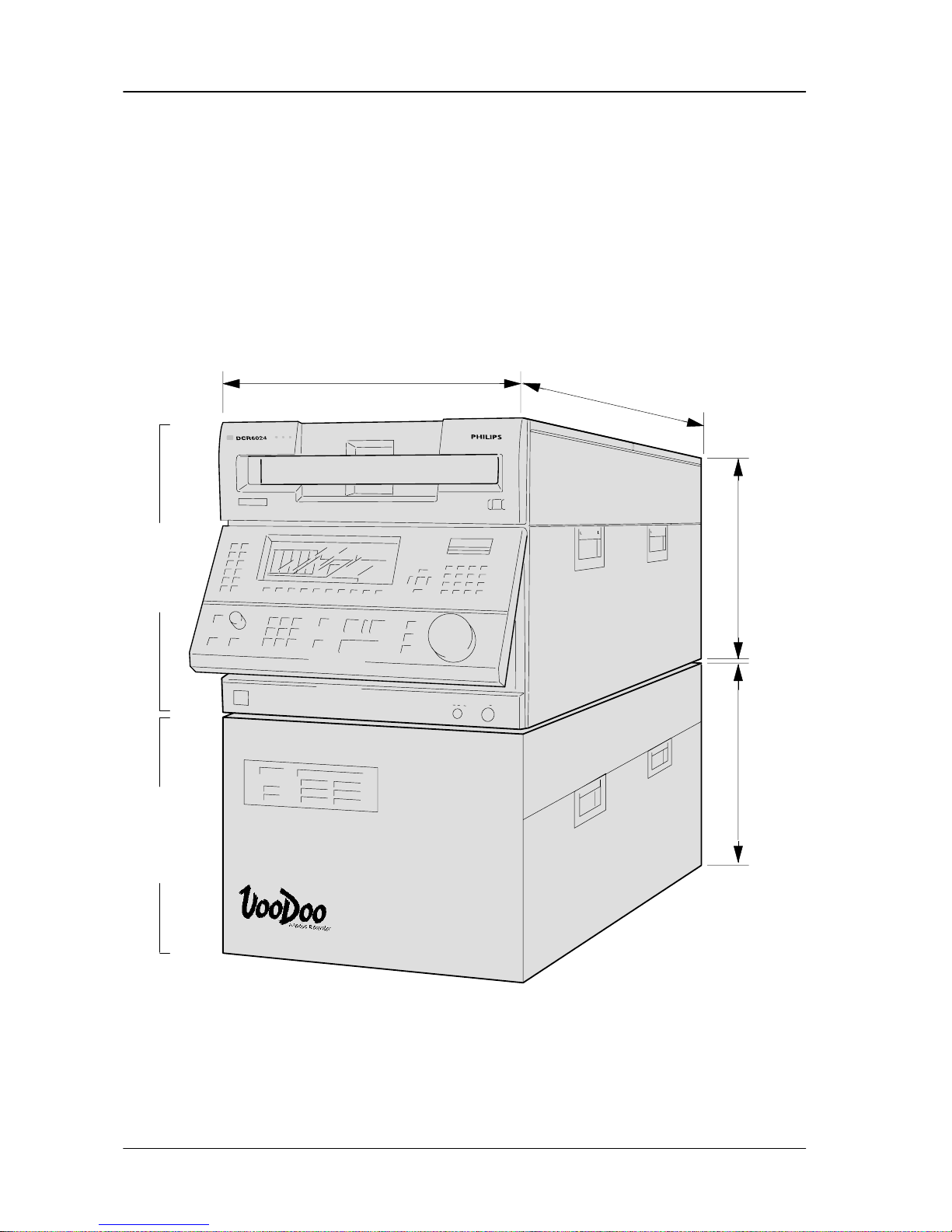
3. Installation DCR 6024/6128/6000
3 – 2
Planning and Installation – Rev. 1 / 7. 2001
3.2 MECHANICAL DIMENSIONS
The DCR 6024 requires a minimum space of 447 x 700 mm at a height of 800 mm
or 18 rack units (RU) of 19 inch cabinet.
Additional space for ventilation or rack mount kit is required.
447 mm
700 mm
397 mm
397 mm
TapedeckProcessor
9 RU
9 RU
(RU = Rack Units)
Fig. 301: DCR 6024 dimensions (without required air inputs for a 19 inch cabinet mounting)
Page 56
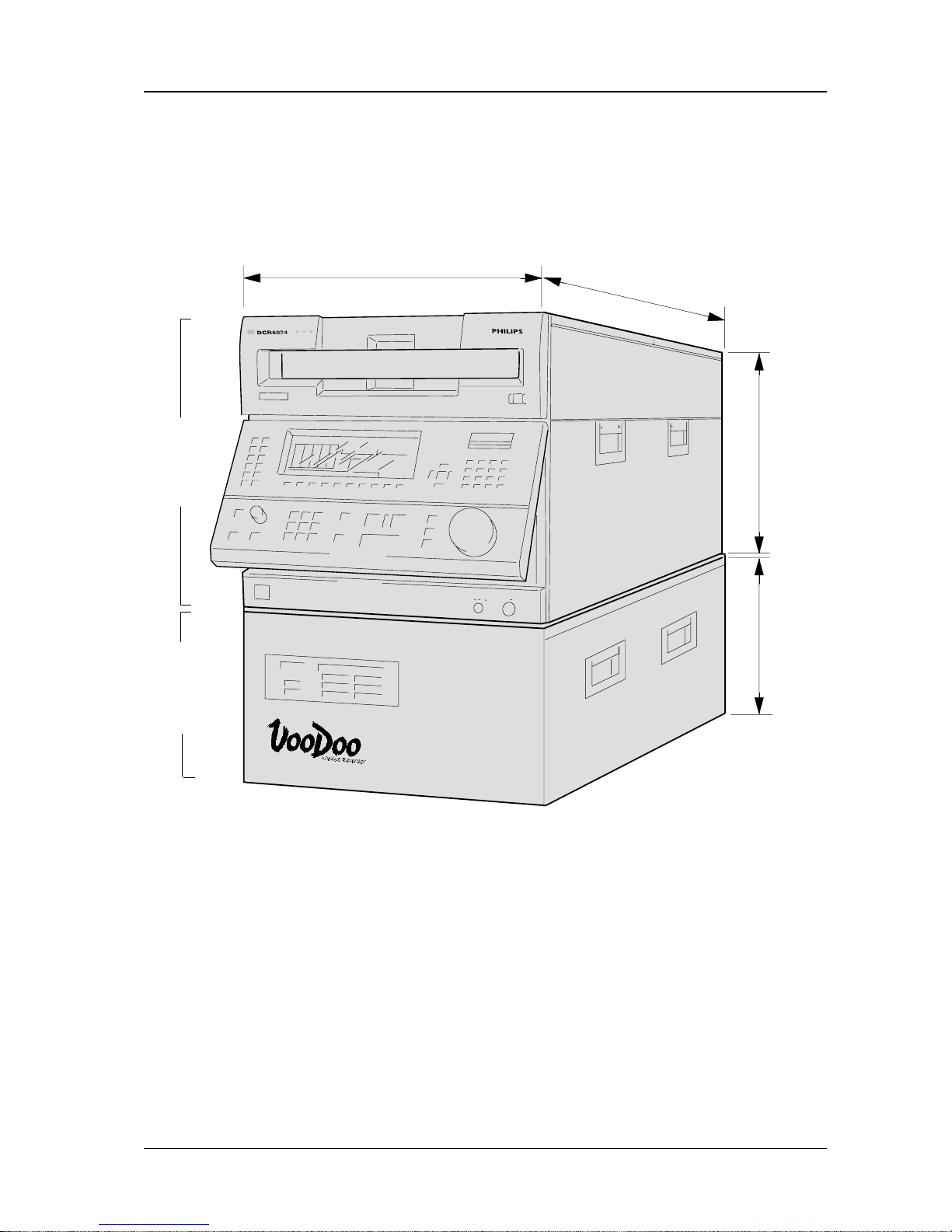
3. InstallationDCR 6024/6128/6000
3 – 3
Planning and Installation – Rev. 1 / 7. 2001
The DCR 6128 requires a minimum space of 447 x 700 mm at a height of 500 mm
or 14 rack units (RU) of 19 inch cabinet. Additional space for ventilation or rack
mount kit is required.
447 mm
700 mm
397 mm
220 mm
TapedeckProcessor
9 RU
5 RU
(RU = Rack Units)
Fig. 302: DCR 6128 dimensions (without required air inputs for a 19 inch cabinet mounting)
Page 57
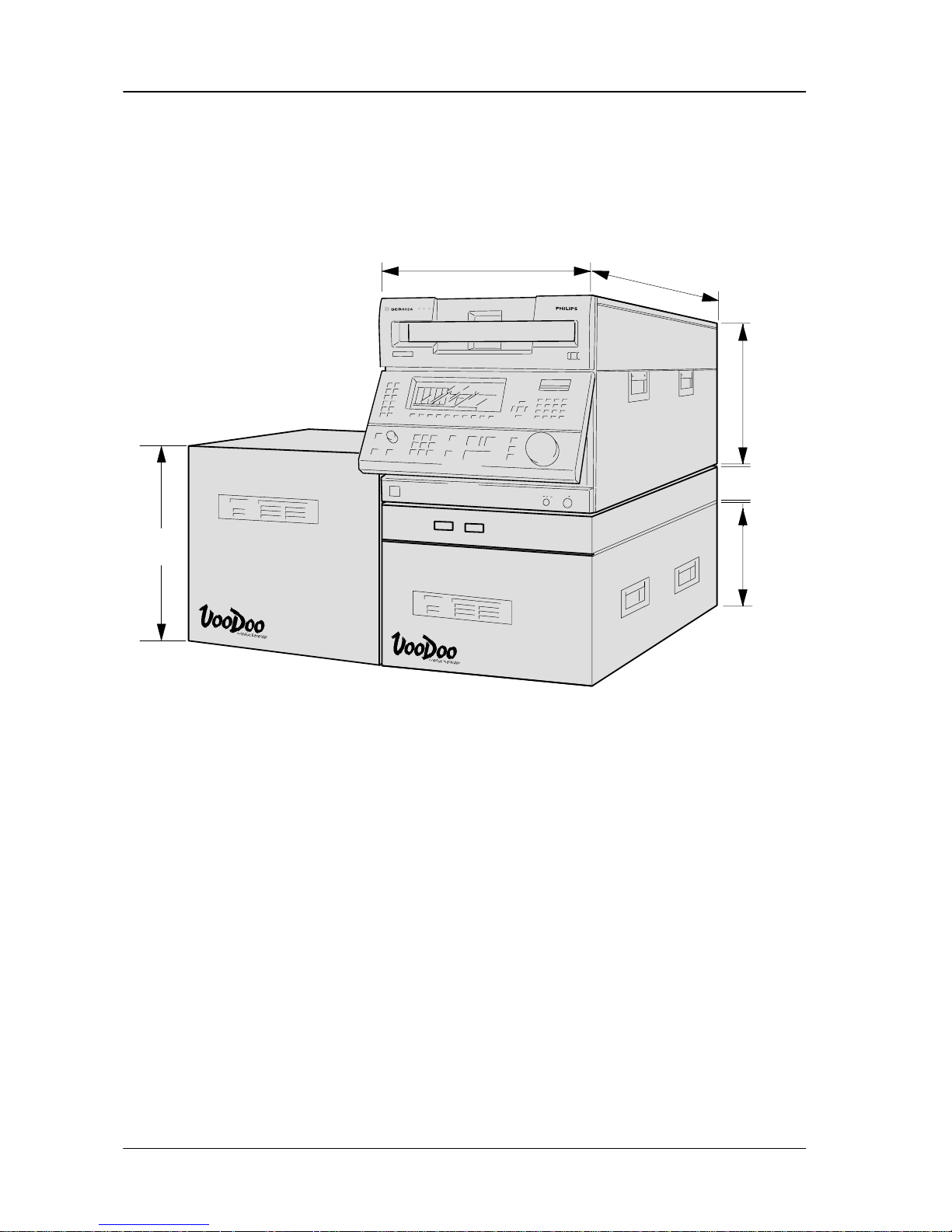
3. Installation DCR 6024/6128/6000
3 – 4
Planning and Installation – Rev. 1 / 7. 2001
The DCR 6000 requires a minimum space of 447 x 700 mm at a height of 1 110 mm
or 25 rack units (RU) of 19 inch cabinet. Additional space for ventilation or rack
mount kit is required.
447 mm
700 mm
397 mm
220 mm
9 RU
5 RU
(RU = Rack Units)
88 mm
2RU
397 mm
9 RU
Fig. 303: DCR 6000 dimensions (without required air inputs for a 19 inch cabinet mounting)
Page 58

3. InstallationDCR 6024/6128/6000
3 – 5
Planning and Installation – Rev. 1 / 7. 2001
3.3 VENTILATION
The ambient temperature during operation must not exceed or fall below the range
of + 10
o
C to +35
o
C. Optimum operation is at an ambient temperature of 25 oC
+/– 5
o
C (see the technical data).
The blowers support the air circulation in the respective unit and lead the heated
air into the room.
When installing the DCR 6024/6128/6000, care should be taken not to cover the
fresh air entries.
Fresh air
Fresh air
Outgoing air
TapedeckProcessor
Outgoing air
Rear Side
Processor
Rear side
Tapedeck
Fresh air
Page 59

3. Installation DCR 6024/6128/6000
3 – 6
Planning and Installation – Rev. 1 / 7. 2001
Fig. 304: Ventilation of DCR 6024
Fresh air
Outgoing air
Tapedeck
Processor
Outgoing air
Rear Side
Processor
Rear side
Tapedeck
Fresh air
Fresh air
Fig. 305: Ventilation of DCR 6128
Fresh air for the Tapedeck is supplied from the right side. Behind the air entries,
filters are located for filtering the fresh air. The heated air is blown out to the rear.
The Tapedeck is provided with four fan units 1 – 4.
The fan plug-in unit 1 comprises three fans and ventilates the p.c. boards behind
the door (see the figure).
The fan plug-in unit 2 comprises one blower and ventilates the vertically arranged
p.c. boards in the upper rear part.
Fan units 3 and 4 cool the Tapedeck mechanism.
The fresh air to the DTV Processor is supplied from below. Behind the air entry, a
filter is located for filtering the fresh air. The heated air is blown out to the rear.
The Processor is provided with a fan plug-in unit comprising four blowers to remove
the heated exhaust air out of the Processor.
The fresh air circulates along at vertically arranged p.c. boards and leaves the device at the rear.
Tapedeck
DTV Processor
Page 60

3. InstallationDCR 6024/6128/6000
3 – 7
Planning and Installation – Rev. 1 / 7. 2001
The fresh air to the Data Processor is supplied from the right side. Behind the air
entry , a filter is located for filtering the fresh air. The heated air is blown out to the
rear.The Processor is provided with a fan plug-in unit comprising three blowers to
remove the heated exhaust air out of the Processor.
The fresh air circulates along at horizontally arranged p.c. boards and leaves the
device at the rear.
The fresh air to the Data Switch is supplied from the right side. The heated air is
blown out to the rear.The Switch is provided with a fan to remove the heated exhaust air out of the Switch.
The fresh air circulates along at horizontally arranged p.c. board and leaves the device at the rear.
Data Processor
Data Switch
Page 61

3. Installation DCR 6024/6128/6000
3 – 8
Planning and Installation – Rev. 1 / 7. 2001
3.4 MOUNTING
There are different ways to install or mount the DCR 6024/6120/6000. In this section, the following possibilities are described:
Mounting Tapedeck on Processor DCR 6024 / DCR 6128
Mounting version s of DCR 6000
Mounting into a 19 inch cabinet
For the future is planned to allow the Control Panel to be remoted from the Tapedeck.
Installing the Control Panel as a remote panel (in preparation!)
Installing the Control Panel as a local panel (delivery state)
ATTENTION!
When installing the DCR 6024/6128/6000, care should be taken not to cover
the fresh air entries to ensure optimum air circulation! See section 3.3 ”Ventilation”.
3.4.1 MOUNTING TAPEDECK ON PROCESSOR
DMS 6000
THOMSO
N
DCR 6024
DDP 6128
PHILIPS
Fig. 306: Mounting Tapedeck on Processor
The Control Panel is already mounted to the Tapedeck when delivered.
The cover of the Processor is provided with four holes for fastening the Tapedeck.
The right rear hole has a locking facility which automatically locks when inserting
and sliding the Tapedeck.
Page 62
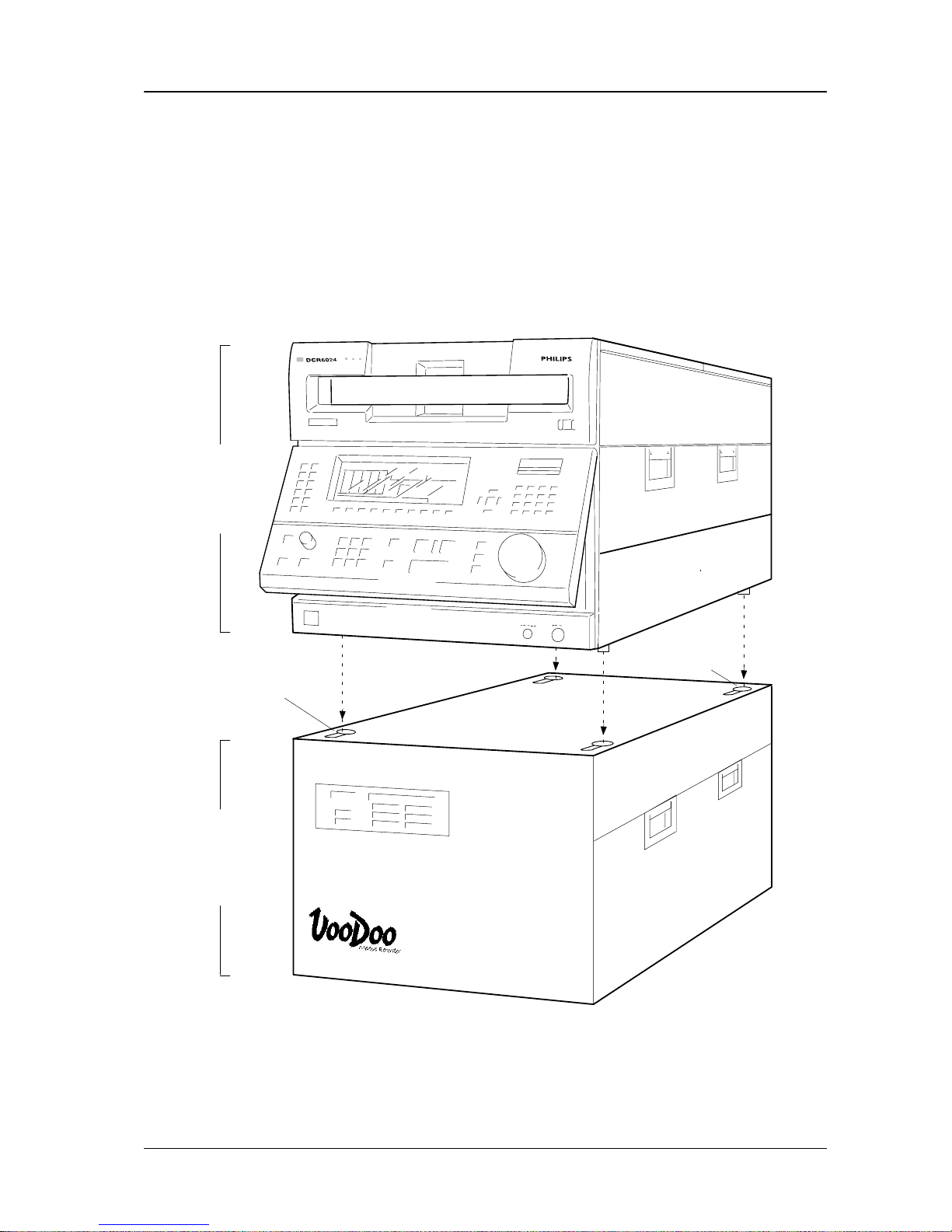
3. InstallationDCR 6024/6128/6000
3 – 9
Planning and Installation – Rev. 1 / 7. 2001
Mounting has to be made as follows:
1. Place the Tapedeck onto the upper side of the Processor. Make sure that the
stands of the Tapedeck fit into the holes in the cover of the Processor.
2. Slide the Tapedeck to the front until the right rear locking facility at the Processor automatically locks.
Note:
Unlocking is made by means of a lever, top left at the rear on the Processor.
4x hole
TapedeckProcessor
Hole with
locking facility
Fig. 307: Mounting DCR 6024
Page 63

3. Installation DCR 6024/6128/6000
3 – 10
Planning and Installation – Rev. 1 / 7. 2001
3.4.2 MOUNTING T APEDECK AND PROCESSOR SIDE BY SIDE
Tapedeck
Processor
Interface
cable
max. 1m
Ventilation
Ventilation
DCR 6024
PHILIPSDCR 6024
Ventilation
(DDP 6128
only)
Fig. 308: Side by side mounting
The modules Tapedeck and Processor can be also arranged side by side with a
space given by the digital interface cable length of 1m at maximum.
ATTENTION! Take care of space for ventilation!
Page 64
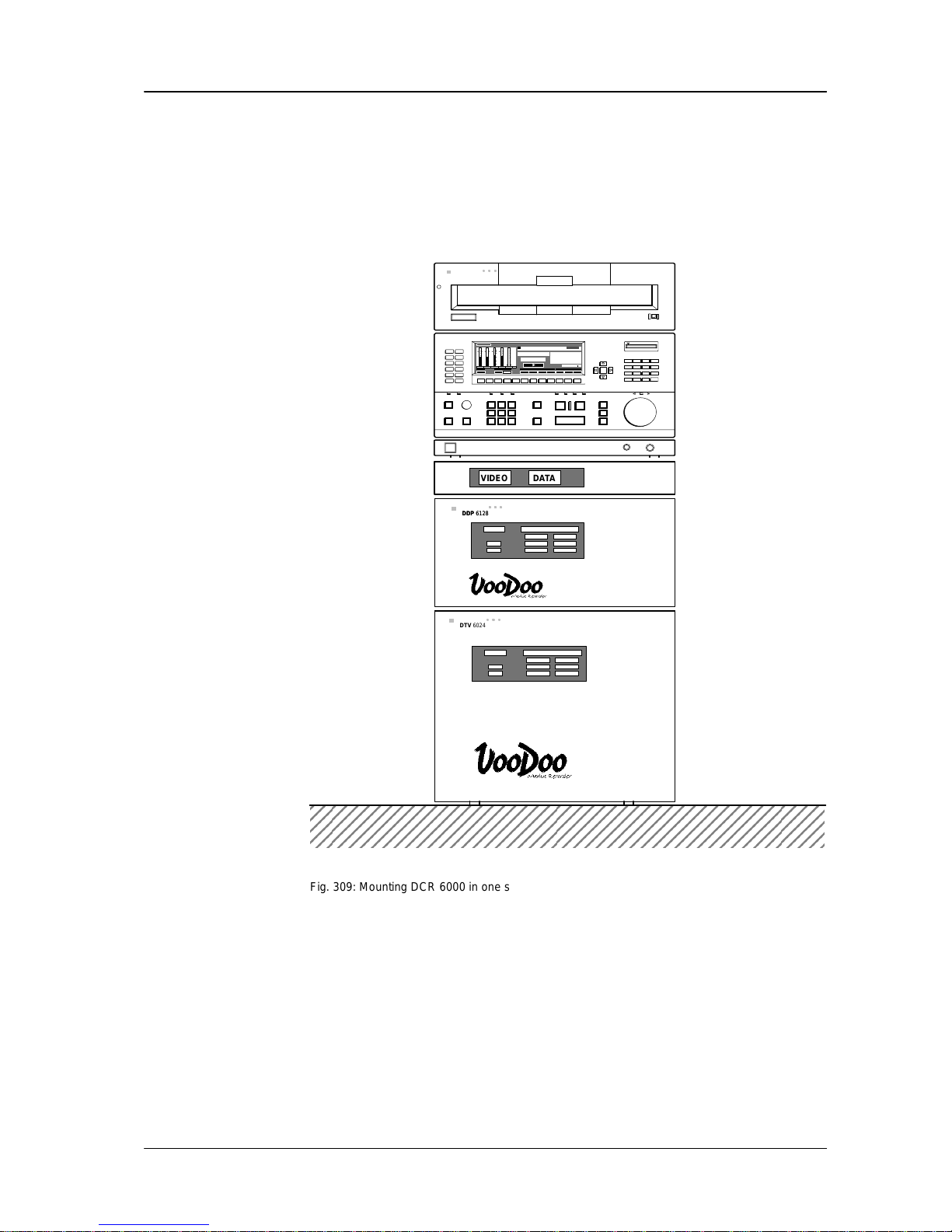
3. InstallationDCR 6024/6128/6000
3 – 1 1
Planning and Installation – Rev. 1 / 7. 2001
3.4.3 MOUNTING VERSIONS OF DCR 6000
There are two different ways to install the DF A recording system DCR 6000. First
is one stack, the second is using one stack for tapedeck and data processor and
a second stack for the DTV processor.
In each configuration the DFata switch should be located under the tapedeck:
DMS 6000
DCR 6024
ЙЙЙЙЙЙЙЙЙЙЙЙЙЙЙЙЙЙЙЙЙЙЙ
ЙЙЙЙЙЙЙЙЙЙЙЙЙЙЙЙЙЙЙЙЙЙЙ
DDP 6128
DATAVIDEO
DTV 6024
DDP 6128
Fig. 309: Mounting DCR 6000 in one stack
Page 65
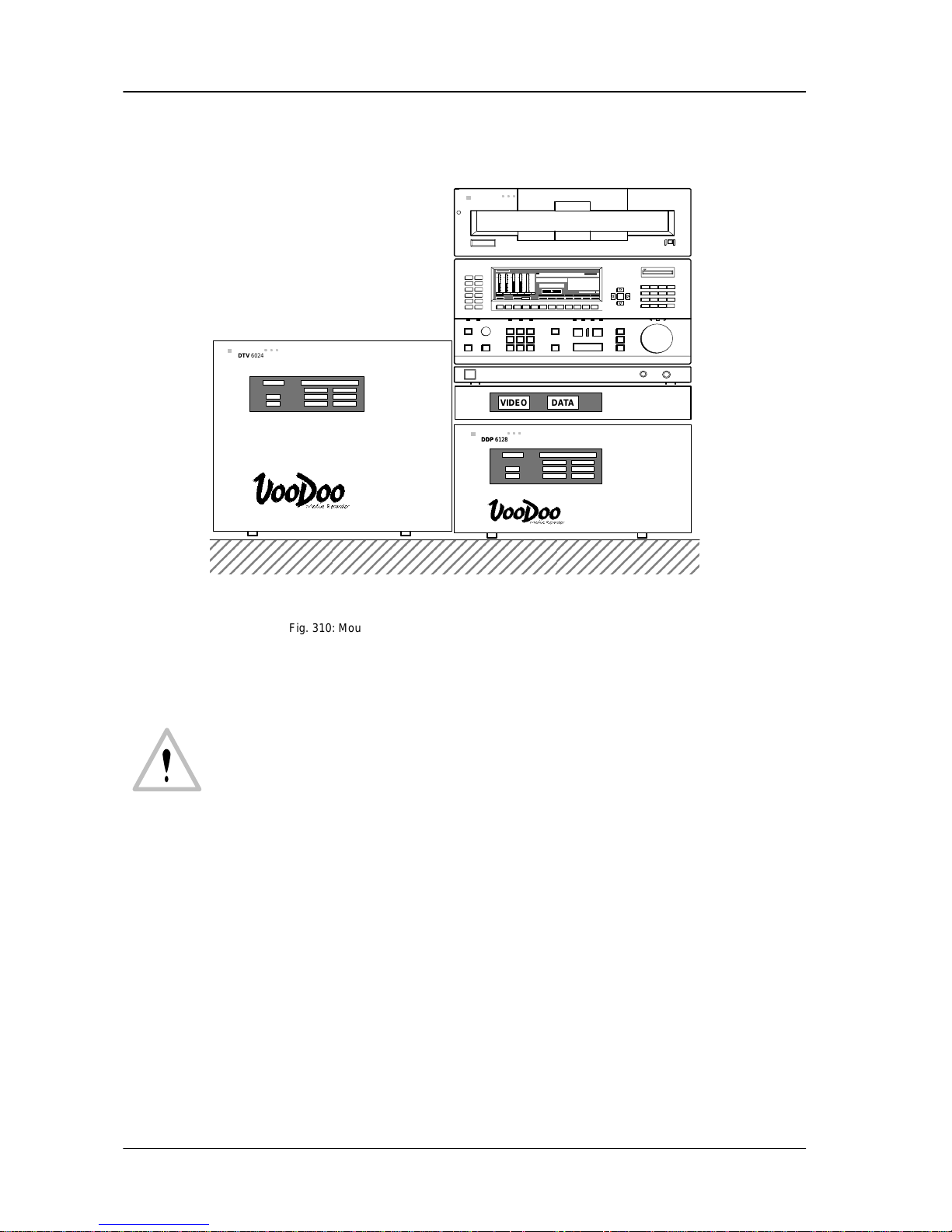
3. Installation DCR 6024/6128/6000
3 – 12
Planning and Installation – Rev. 1 / 7. 2001
DMS 6000
DCR 6024
DDP 6128
DATAVIDEO
DTV 6024
DDP 6128
Fig. 310: Mounting DCR 6000 in two stacks
The Data Switch DSW 6000 was designed to use only in combination with a DMS
6000 tapedeck and a processor DDP 6128 or DTV 6024.
Data Switch
Page 66

3. InstallationDCR 6024/6128/6000
3 – 13
Planning and Installation – Rev. 1 / 7. 2001
3.4.4 MOUNTING INTO A 19-INCH CABINET
19-inch rack mount kits are provided for mounting the Processors
and the Tapedeck into a 19-inch rack cabinet and allows
sliding out the Tapedeck for service and maintenance works:
designation 19-inch rack mount kit for Tapedeck DMS 6000
type BD 5197-2
order number 0 175 602 211
designation 19-inch rack mount kit for DTV Processor DTV 6024
type BD 5198
order number 0 175 602 310
designation 19-inch rack mount kit for Data Processor DDP 6128
type BD 5199
order number 0 175 602 410
THOMSON recommends cabinets with a mounting depth of 900 mm.
The maximum mounting height depends on the selected version and configuration.
3.4.4.1 SAFETY HAZARDS
Prior to mounting the rack mount kit into a 19-inch rack cabinet, secure
the cabinet against overturning (e.g. fasten it on the floor).
In order to ensure free air circulation, make sure that the fresh air entry on the
front, bottom and right side and the outlet of the warmed air on the rear side are
not obstructed.
For mounting the DCR 6024 into a 19-inch rack cabinet use the separate
description “Mounting Instruction for DCR 6024/6128/6000 into a 19-inch rack cabinet”.
Page 67
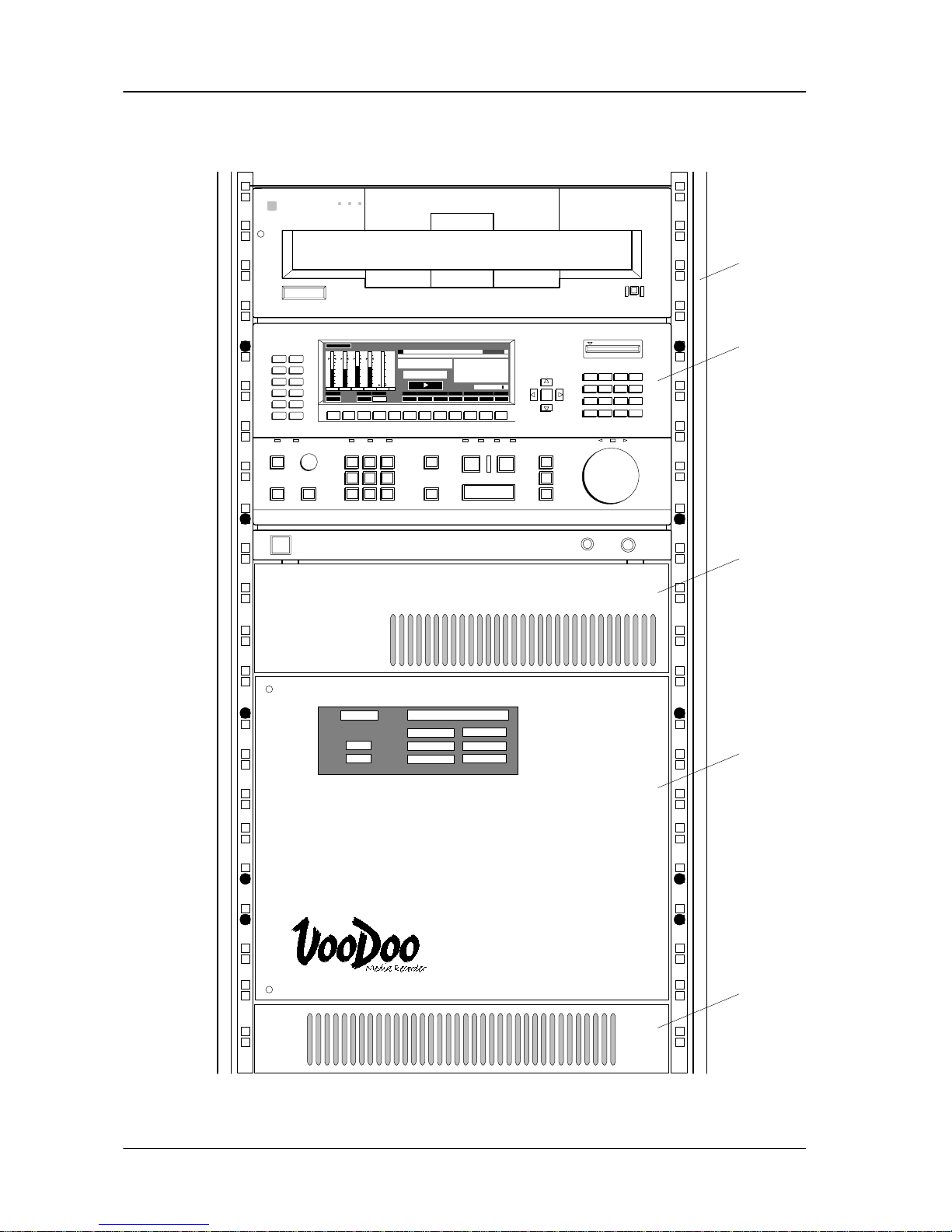
3. Installation DCR 6024/6128/6000
3 – 14
Planning and Installation – Rev. 1 / 7. 2001
3.4.4.2 Example : DCR 6024 built-in into a 19 inch cabinet
Rack
PHILIPS
DCR 6024
DCR 6024
Tapedeck
Air input
Tapedeck
Air input
Processor
Processor
REFERENCE
INT
EXT
ALARM
SYSTEM
ERROR RATE
VIDEO CONCEAL
AUDIO INPUT
AUDIO MUTE
VIDEO INPUT
Fig. 311: DCR 6024 built-in into a 19 inch cabinet
Page 68

3. InstallationDCR 6024/6128/6000
3 – 15
Planning and Installation – Rev. 1 / 7. 2001
3.4.5 INSTALLING CONTROL PANEL AS REMOTE PANEL
(in preparation)
Fig. 312: Control Panel DCH 6024 CP of the DMS 6000, front view
Page 69
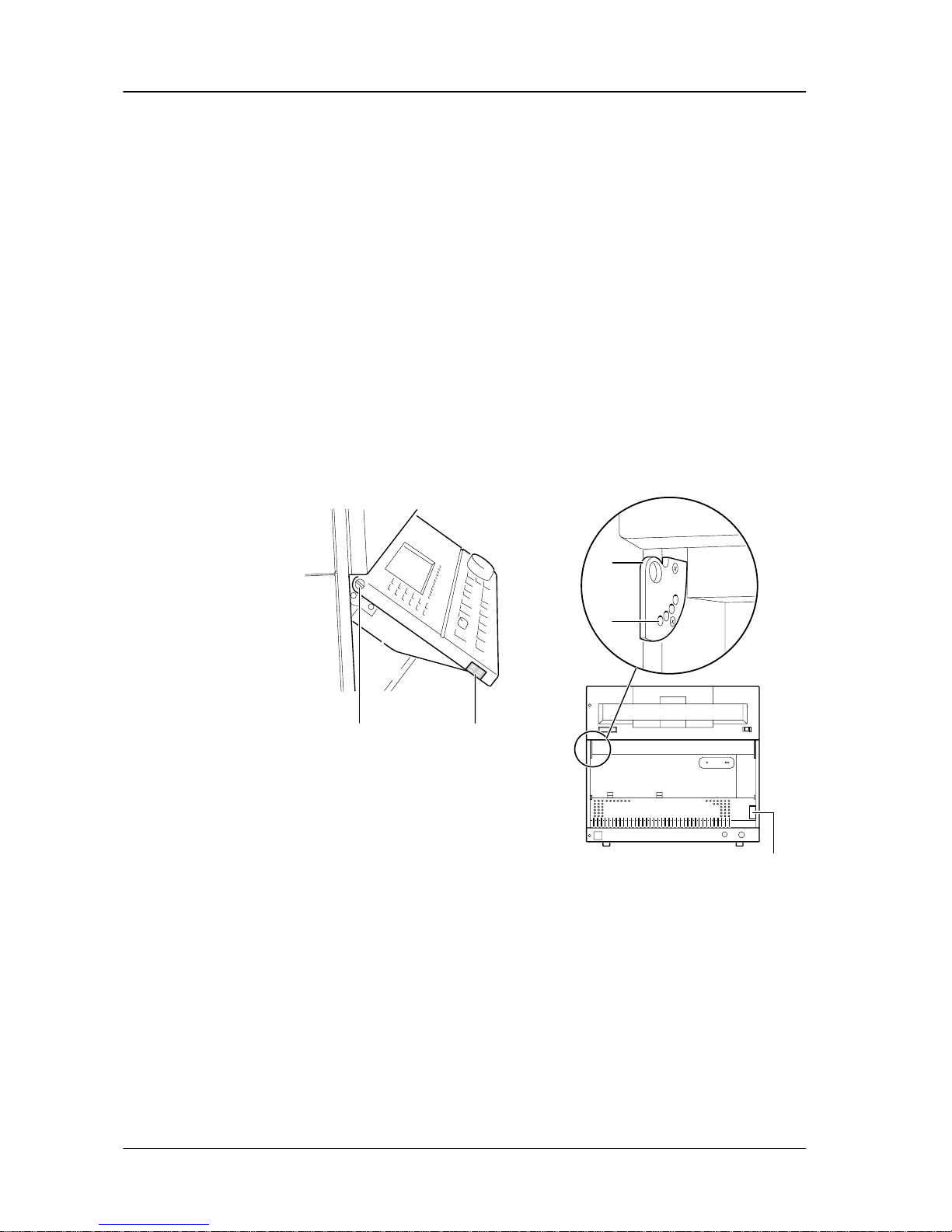
3. Installation DCR 6024/6128/6000
3 – 16
Planning and Installation – Rev. 1 / 7. 2001
3.4.6 INSTALLING THE CONTROL PANEL AS LOCAL PANEL
Control Panel installation at the T apedeck for local operation
For local operation, the Control Panel is mounted at the front of the Tapedeck as
follows:
1. Open the mounting locks at the upper left and right side of the Panel (fig. A.1)
by counterclockwise rotation with an appropriate screwdriver or a coin.
2. Push the locking buttons at the lower left and right side of the Panel (fig. A.2)
and keep them pushed. Place the panel in the mounting brackets (oblique
downwards) (fig. B.3). Release the locking buttons and slightly tilt the Control
Panel up until the locking bolts lock in one of the holes (fig. B.2) of the mounting
brackets on both sides.
3. Bring the mounting locks (fig. A.1) into the holes (if necessary, slightly move
the Control Panel up and down) and tighten them by clockwise rotation.
4. Connect the panel at the 15-pin socket and fasten the connector (fig. C.1) with
a small screwdriver.
1
1
3
2
2
Tapedeck
A
B
C
Fig. 313: Mounting the control panel
Page 70
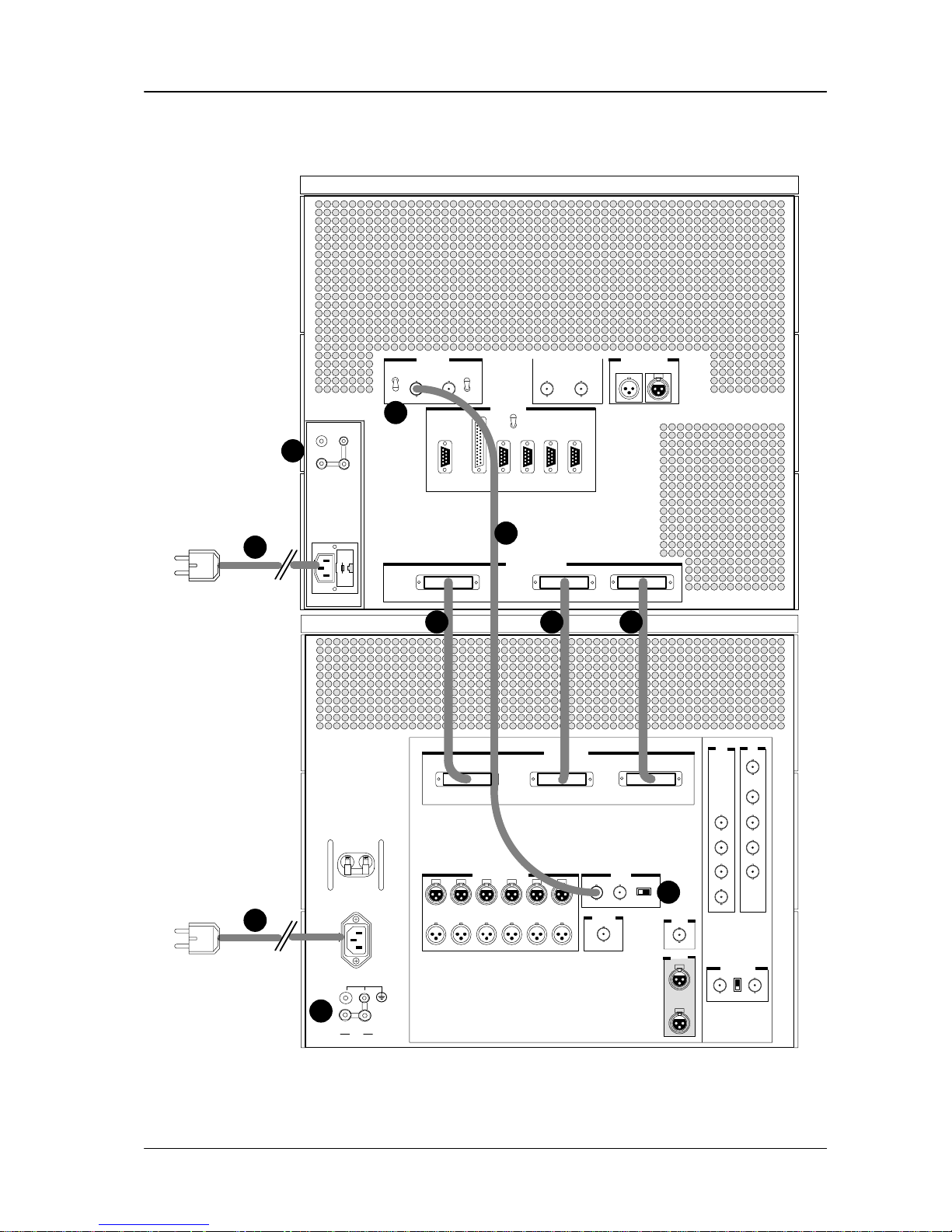
3. InstallationDCR 6024/6128/6000
3 – 17
Planning and Installation – Rev. 1 / 7. 2001
3.5 STANDARD CONNECTIONS DCR 6024
R
L
AUDIO
MONI
PE
PB - DATA
IN OUT
REM 3
REM 1
OFF
AudioTEVideo
(PE)
OFF
SIGNAL
RS 232C REM 2
OUTIN
REC - DATA CONTROL
iMCS
TO PROCESSOR
AC IN
50 50
CONTROLREC DATAPB DATA
75
OFF
IMCS
AUDIO DIGITAL I/O
11/129/107/85/63/41/2
OUT
IN
CH
50
BREAKER
OFF
WAVE FORM MONITOR TIME CODE
TERM
ON
OFF
TRIGGER
REMOTE
FUSE 2x T6.25A
TO TAPEDECK
SDI
IN
BUFF
OUT
OUT1
OUT2
OUT3
MONI OUT
G/Y
R/PR
B/PB
SYNC
NTSC/PAL
SYNC OUT
48 KHz
OUT
REF SYNC
PLAYBACK
AC IN
ATEV
PE
2
2
3 4 55
6
7
8
1
1
Page 71
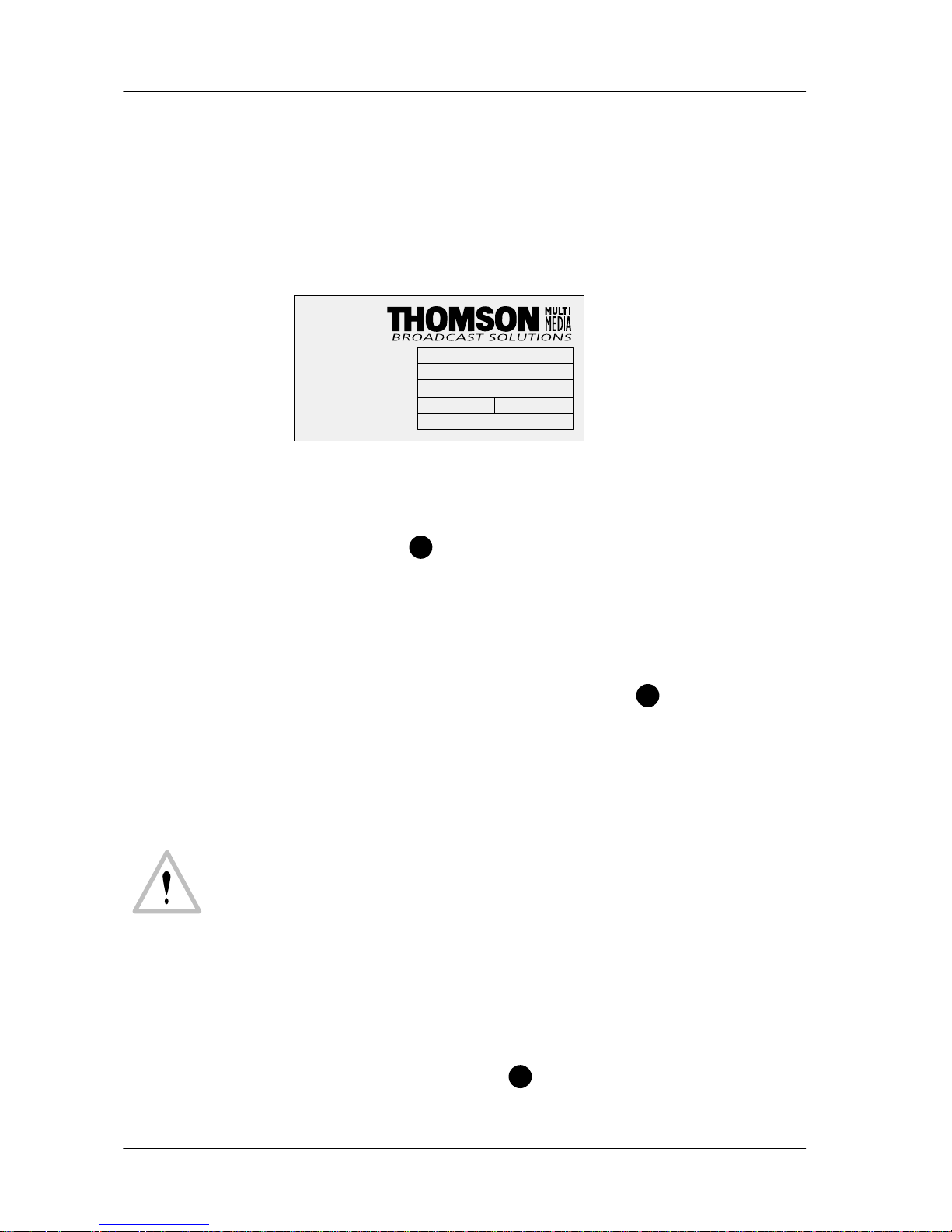
3. Installation DCR 6024/6128/6000
3 – 18
Planning and Installation – Rev. 1 / 7. 2001
3.5.1 CONNECT THE CONNECTION CABLES (included in the delivery)
Tapedeck and Processor are connected separately to the line voltage.
The Tapedeck , the Processors and the Switch Box include wide-range power sup-
ply units of 100V – 240V so that no changeover is required for different line voltages.
TYPE
PART / SER. NO.
STANDARD
POWER AC
FREQUENCY
000 175 091 000
DDP 6128
100V - 240V
47 - 63 Hz
HIPPI
/ 103
2,4 A – 1 A
Fig. 314: Type label at the Tapedeck rear
For connecting to power, two cables have to be connected:
2x mains cable
The mains cables 1 have to be connected to Tapedeck and Processor at the
MAINS IN sockets
The protective earth is connected via the available protective contact of the mains
connector. The mains cable, however, must be plugged into an earthing-contact
type socket only.
Tapedeck and Processor are provided on the rear with separate terminals for connecting protective earth (PE) and technical earth (TE) 2.
Details about these connection facilities are contained in the section 4.5.1.1
”Grounding of the Tapedeck” and section 4.6.1.1 ”Grounding of the Processor”.
When the device is delivered, the terminals PE and TE are joined by jumpers.
These jumpers have only to be broken for separate technical (Video/Audio) earth
connections.
The case of the DCR 6024 is always connected to the protective conductor PE.
Any disconnection or break of the protective earth (PE) conductor inside or
outside the device may entail that, in the event of a failure, the operational
safety of the device will no longer be ensured.
For the data signals between Tapedeck and Processor, the following three cables,
supplied with the Processor have to be connected:
1. 50-pole connection cable
Connect the connection cable 3 at Tapedeck and Processor to the sockets
PB DA TA.
Power connection
Type label
Mains cord
Earth
connection
Signal
connection
Page 72
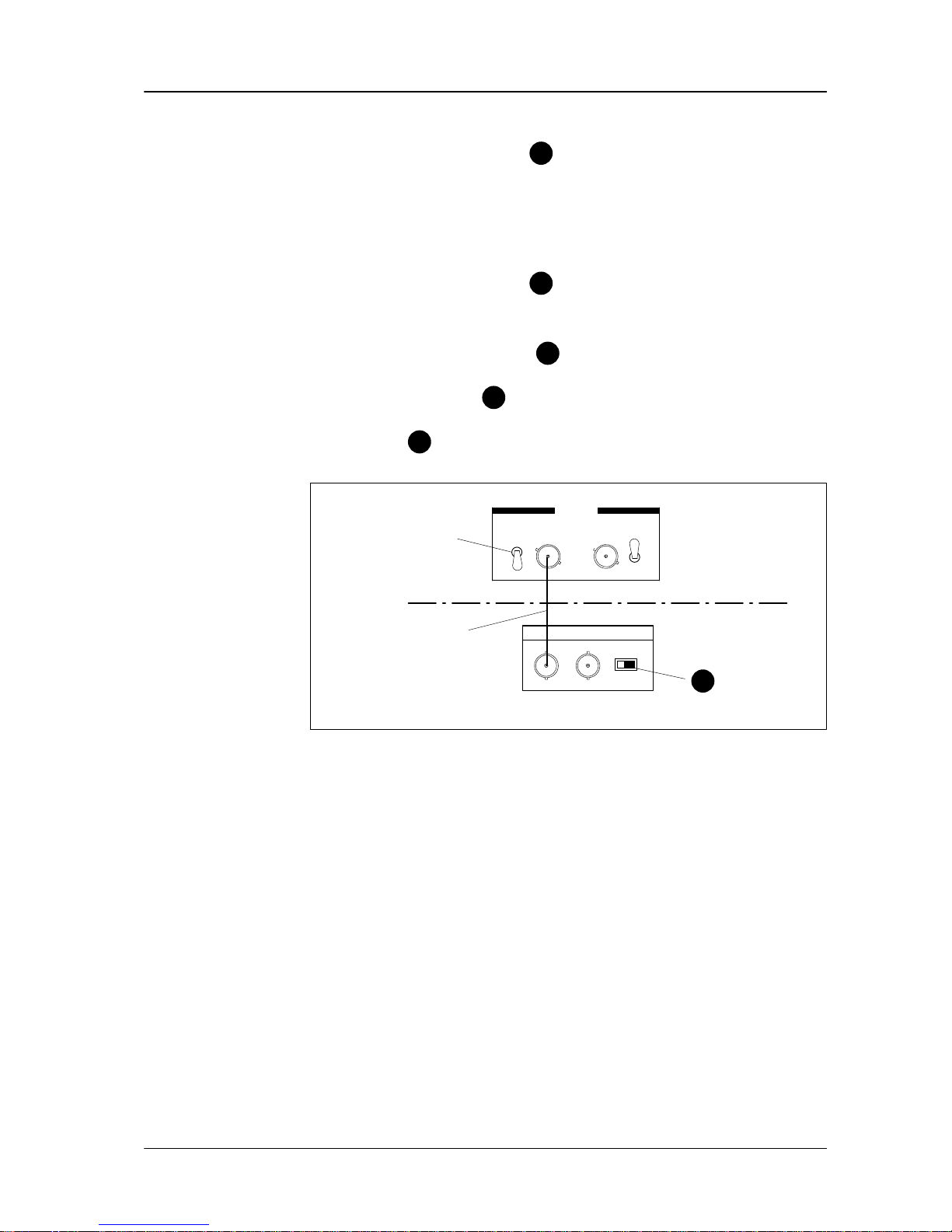
3. InstallationDCR 6024/6128/6000
3 – 19
Planning and Installation – Rev. 1 / 7. 2001
2. 50-pole connection cable
Connect the connection cable
4
at Tapedeck and Processor to the sockets
REC DA TA.
For control between Tapedeck and Processor, connect the following two cables (included in the delivery):
1. 50-pole connection cable
Connect the connection cable
55
at Tapedeck and Processor to the sockets
CONTROL.
2. Cheapernet cable KV 0770
Connect the Cheapernet cable 6 at Tapedeck and Processor to one of the
the two iMCS sockets.
The associated switch 7 at the iMCS socket of the Tapedeck has to be set
to OFF.
The switch 8 at the iMCS socket of the Processor has to be set to 50
OFF OFF
iMCS
50 50
Tapedeck
OFF
iMCS
Processor
Switch ”OFF”
Switch
Cheapernet cable
KV 0770
8
Fig. 315: Cheapernet connection
The individual external connections are described in the section 6 ’Connections’.
Connection facilities or connection proposals are contained in the section 4 ’System Configuration’.
Control
connection
External connection
Page 73
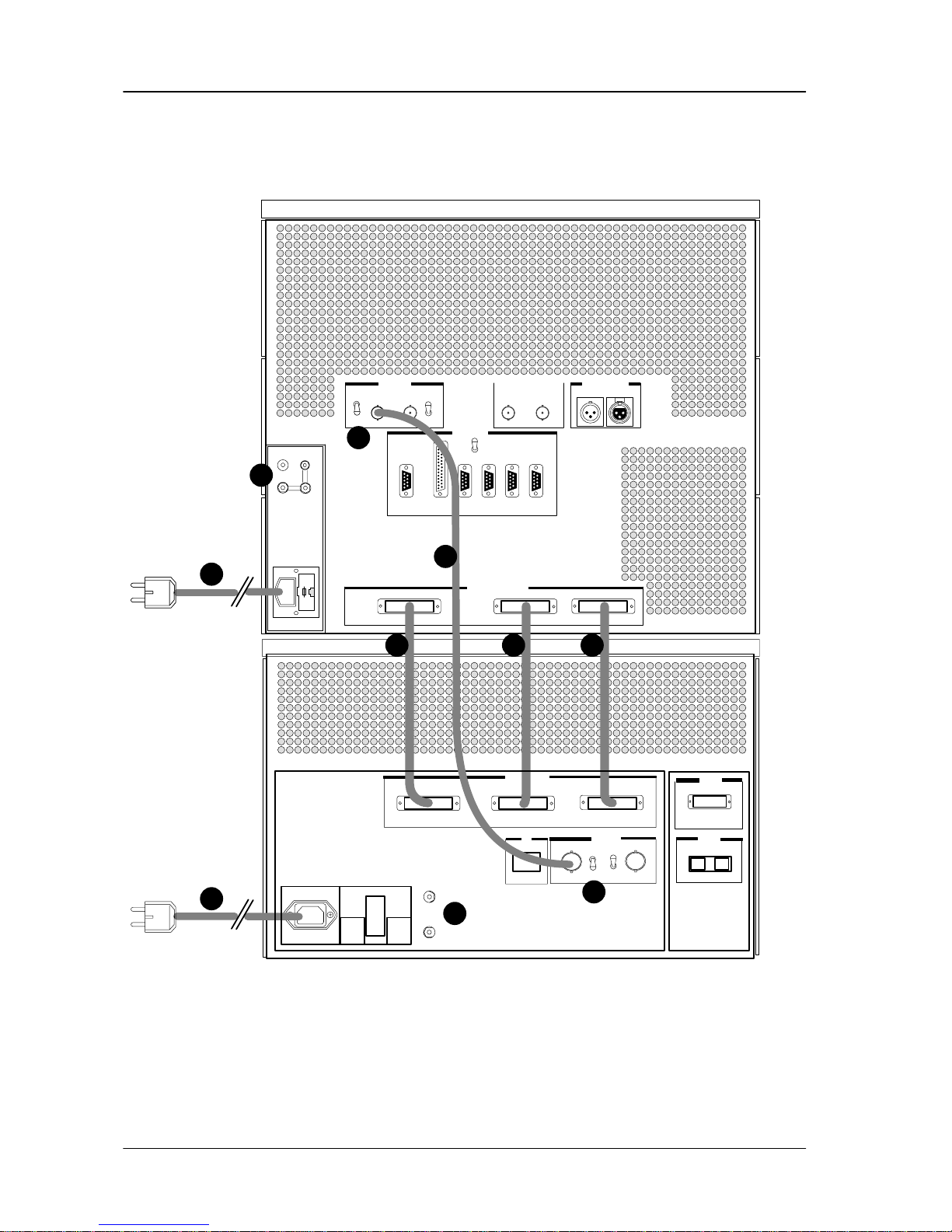
3. Installation DCR 6024/6128/6000
3 – 20
Planning and Installation – Rev. 1 / 7. 2001
3.6 STANDARD CONNECTIONS DCR 6128
Connect the inputs and outputs for data and DPX monitoring and iMCS
PE
PB - DATA
IN OUT
REM 3
REM 1
OFF
AudioTEVideo
(PE)
OFF
SIGNAL
RS 232C REM 2
OUTIN
REC - DATA CONTROL
iMCS
TO PROCESSOR
AC IN
50 50
CONTROLREC DATAPB DATA
IMCS
AC IN
PE
WAVE FORM MONITOR TIME CODE
TERM
ON
OFF
TRIGGER
REMOTE
FUSE 2x T6.25A
TO TAPEDECK
OFF
50
OFF
50
IP
POWER
1
0
MONI
HIPPI
TE
OUT
IN
1
1
2
2
3 4 55
6
7
7
Fig. 316: Standard connections DCR 6128
Page 74
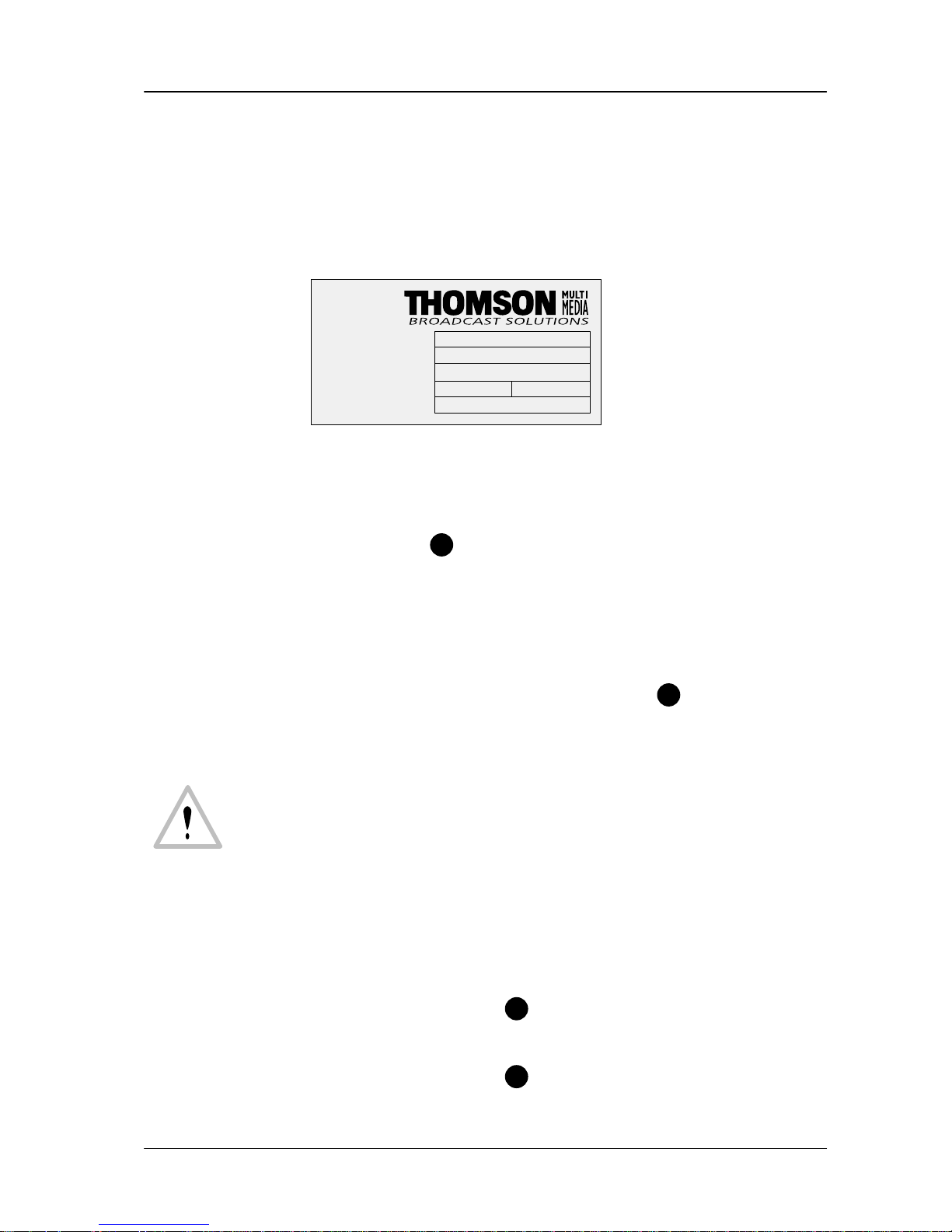
3. InstallationDCR 6024/6128/6000
3 – 21
Planning and Installation – Rev. 1 / 7. 2001
3.6.1 CONNECT THE CONNECTION CABLES (INCLUDED IN THE DELIVERY)
Tapedeck and Processor are connected separately to the line voltage.
The Tapedeck , the Processors and the Switch Box include wide-range power sup-
ply units of 100V – 240V so that no changeover is required for different line voltages.
TYPE
PART / SER. NO.
STANDARD
POWER AC
FREQUENCY
000 175 091 000
DDP 6128
100V - 240V
47 - 63 Hz
HIPPI
/ 103
2,4 A – 1 A
Fig. 317: Type label at the Tapedeck rear
For connecting to power, two cables have to be connected:
2x mains cable
The mains cables 1 have to be connected to Tapedeck and Processor at the
MAINS IN sockets
The protective earth is connected via the available protective contact of the mains
connector. The mains cable, however, must be plugged into an earthing-contact
type socket only.
Tapedeck and Processor are provided on the rear with separate terminals for connecting protective earth (PE) and technical earth (TE) 2.
Details about these connection facilities are contained in the section 4.5.1.1
”Grounding of the Tapedeck” and section 4.6.1.1 ”Grounding of the Processor”
When the device is delivered, the terminals PE and TE are joined by jumpers.
These jumpers have only to be broken for separate technical (Video/Audio) earth
connections.
The case of the DCR 6128 is always connected to the protective conductor PE.
Any disconnection or break of the protective earth (PE) conductor inside or
outside the device may entail that, in the event of a failure, the operational
safety of the device will no longer be ensured.
For the data signals between Tapedeck and Processor, the following three cables,
supplied with the Processor have to be connected:
50-pole connection cable
Connect the connection cable 3 at Tapedeck and Processor to the sockets
PB DA TA.
50-pole connection cable
Connect the connection cable 4 at Tapedeck and Processor to the sockets
REC DA TA.
Power connection
Type label
Mains cord
Earth
connection
Signal
connection
Page 75

3. Installation DCR 6024/6128/6000
3 – 22
Planning and Installation – Rev. 1 / 7. 2001
For control between Tapedeck and Processor, connect the following two cables (included in the delivery):
50-pole connection cable
Connect the connection cable 55 at Tapedeck and Processor to the sockets
CONTROL.
Cheapernet cable KV 0770
Connect the Cheapernet cable 6 at Tapedeck and Processor to one of the the
two iMCS sockets.
The associated switch 7 at the iMCS socket of the Tapedeck and Data Processor
have to be set to OFF.
OFF OFF
iMCS
50 50
Tapedeck
iMCS
Processor
Switch ”OFF”
Cheapernet cable
KV 0770
OFF
50
OFF
50
Switch ”OFF”
Fig. 318: Cheapernet connection
The individual external connections are described in the section 6 ’Connections’.
Connection facilities or connection proposals are contained in the section 4 ’System Configuration’.
Control
connection
External connection
Page 76

3. InstallationDCR 6024/6128/6000
3 – 23
Planning and Installation – Rev. 1 / 7. 2001
3.7 STANDARD CONNECTIONS DCR 6000
R
L
AUDIO
MONI
PE
PB - DATA
IN OUT
REM 3
REM 1
OFF
AudioTEVideo
(PE)
OFF
SIGNAL
RS 232C REM 2
OUTIN
REC - DATA CONTROL
iMCS
TO PROCESSOR
AC IN
50 50
CONTROLREC DATAPB DATA
75
OFF
IMCS
AUDIO DIGITAL I/O
11/129/107/85/63/41/2
OUT
IN
CH
50
BREAKER
OFF
WAVE FORM MONITOR TIME CODE
TERM
ON
OFF
TRIGGER
REMOTE
FUSE 2x T6.25A
TO TAPEDECK
SDI
IN
BUFF
OUT
OUT1
OUT2
OUT3
MONI OUT
G/Y
R/PR
B/PB
SYNC
NTSC/PAL
SYNC OUT
48 KHz
OUT
REF SYNC
PLAYBACK
AC IN
ATEV
PE
CONTROLREC DATAPB DATA
IMCS
AC IN
PE
TO TAPEDECK
OFF
50
OFF
50
IP
POWER
1
0
MONI
HIPPI
TE
OUT
IN
CONTROLREC DATAPB DATA
AC IN
TO TAPEDECK
TO DATA PROCESSOR
TO VIDEO PROCESSOR
REMOTE CONTROL
TEST
PUSH SW
PE
TE
Fig. 319: Standard connections DCR 6000
Page 77

3. Installation DCR 6024/6128/6000
3 – 24
Planning and Installation – Rev. 1 / 7. 2001
3.7.1 CONNECT THE CONNECTION CABLES (INCLUDED IN THE DELIVERY)
Tapedeck,Processors and Data Switch are connected separately to the line voltage.The Tapedeck, the Processors and the Switch Box include wide-range power
supply units of 100V – 240V so that no changeover is required for different line voltages.
For Earth connections refer to the instructions of DCR 6024 or DCR 6128
Connect the three cables PB DA TA REC DATA and CONTROL from Tapedeck,
to the corresponding connectors of the Data Switch
Connect the three cables PB DATA REC DATA and CONTROL from DTV
Processor to the corresponding connectors on the Data Switch
Connect the three cables PB DATA REC DATA and CONTROL from Data
Processor to the corresponding connectors on the Data Switch
Install iMCS network between Tapedeck, DTV Processor and Data Processor.
check for proper termination.
Connect the remote control cable for the Data Switch from REM 3 of Tapedeck to
the REMOTE CONTROL connector of the Data Switch.
Power connection
Signal connection
Page 78
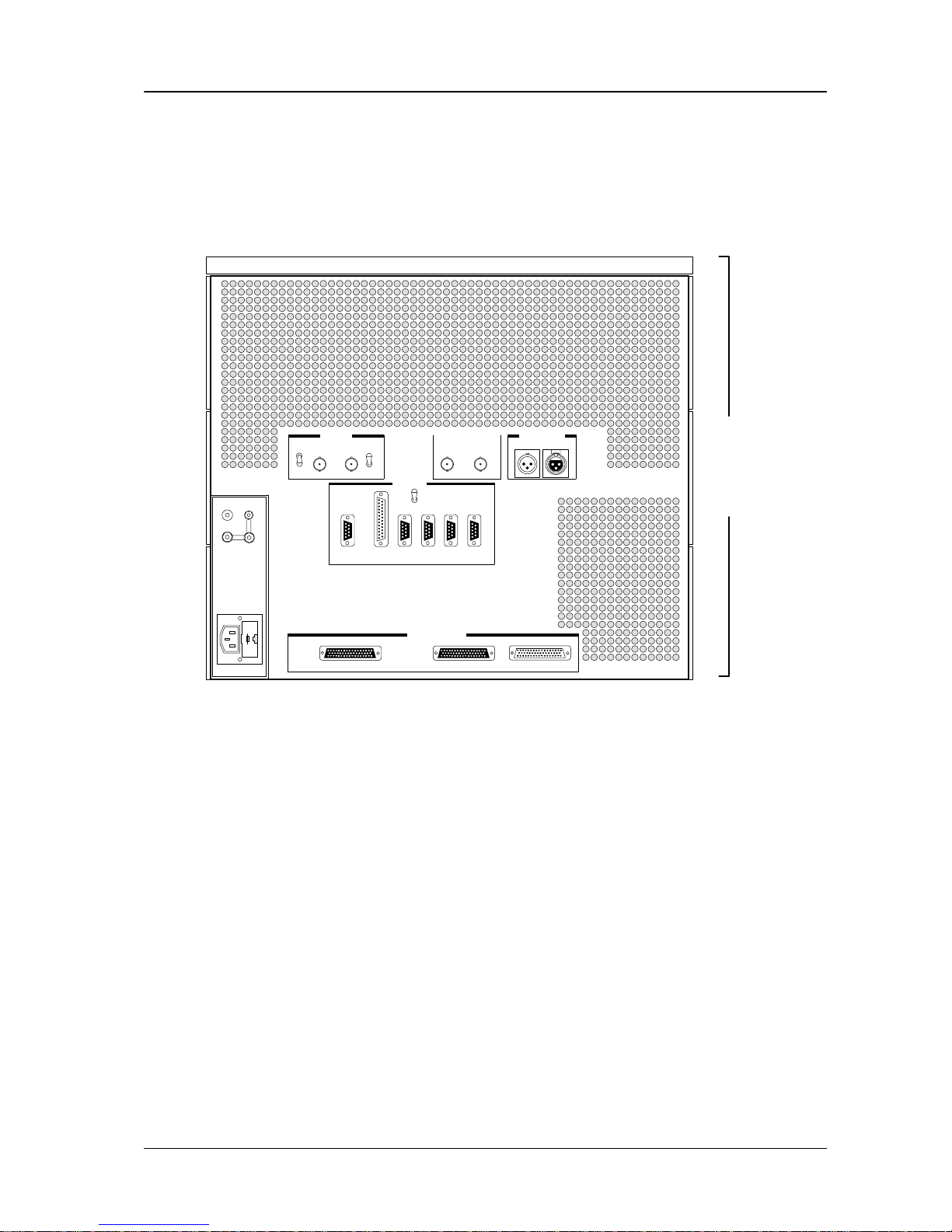
4. ConnectionsDCR 6024/6128/6000
4 – 1
Planning and Installation – Rev . 1 / 7. 2001
4. CONNECTIONS
4.1 REAR VIEW DMS 6000
This section describes all connections of the DMS 6000
PE
PB - DATA
IN OUT
REM 3
REM 1
OFF
AudioTEVideo
(PE)
OFF
SIGNAL
RS 232C REM 2
OUTIN
REC - DATA CONTROL
iMCS
TO PROCESSOR
AC IN
50 50
WAVE FORM MONITOR TIME CODE
TERM
ON
OFF
TRIGGER
REMOTE
Tapedeck
FUSE 2X T6.25A
Fig. 401: Connections (rear view) DMS 6000
Page 79
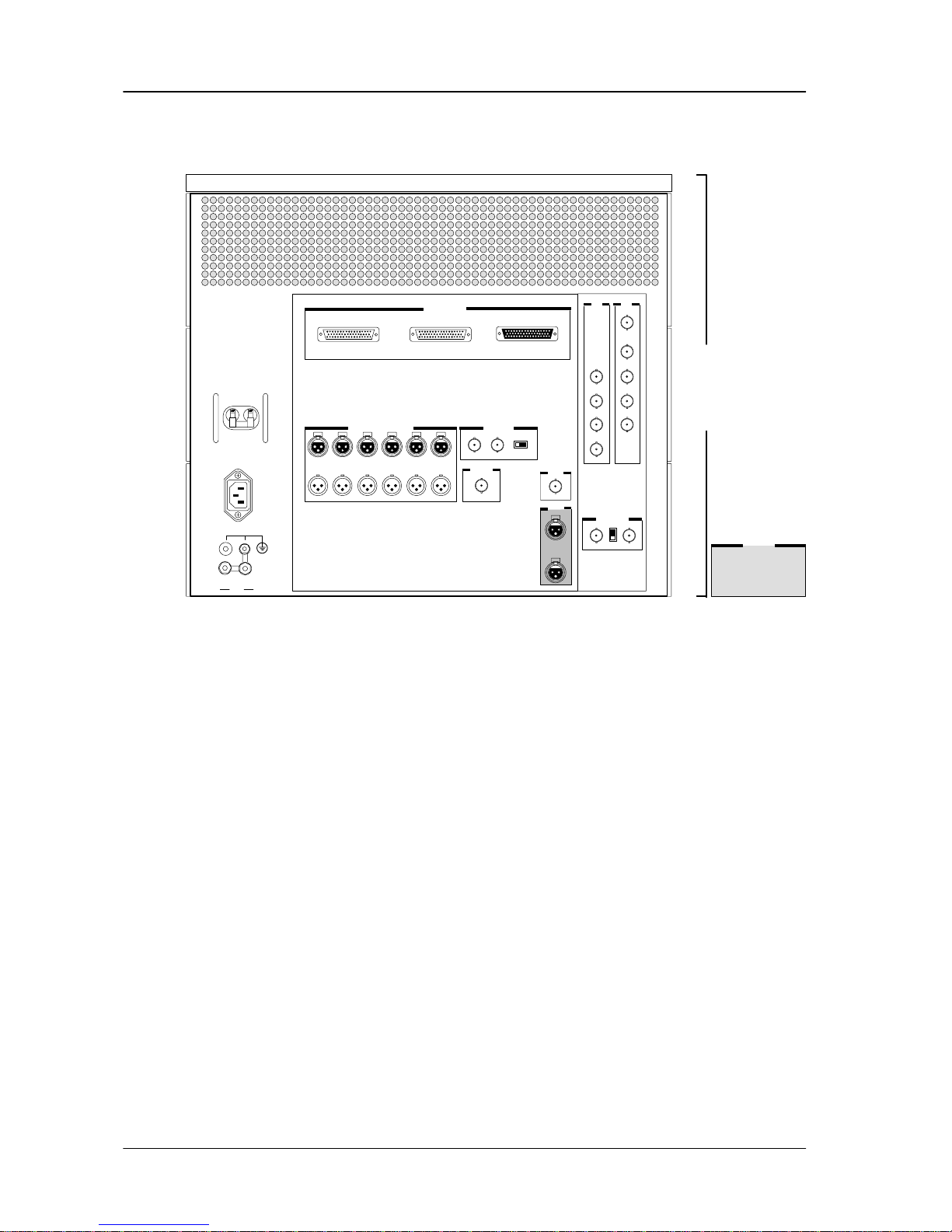
4. Connections DCR 6024/6128/6000
4 – 2
Planning and Installation – Rev. 1 / 7. 2001
4.2 REAR VIEW DTV 6024
CONTROLREC DATAPB DATA
75
OFF
IMCS
R
L
AUDIO DIGITAL I/O
11/129/107/85/63/41/2
OUT
IN
CH
50
AC IN
BREAKER
OFF
Processor
TO TAPEDECK
SDI
IN
BUFF
OUT
OUT1
OUT2
OUT3
AUDIO
MONI
MONI OUT
G/Y
R/PR
B/PB
SYNC
NTSC/PAL
SYNC OUT
48 KHz
OUT
REF SYNC
PLAYBACK
= Option !
ATEV
PE
Fig. 402: Connections (rear view) DTV 6024
Page 80
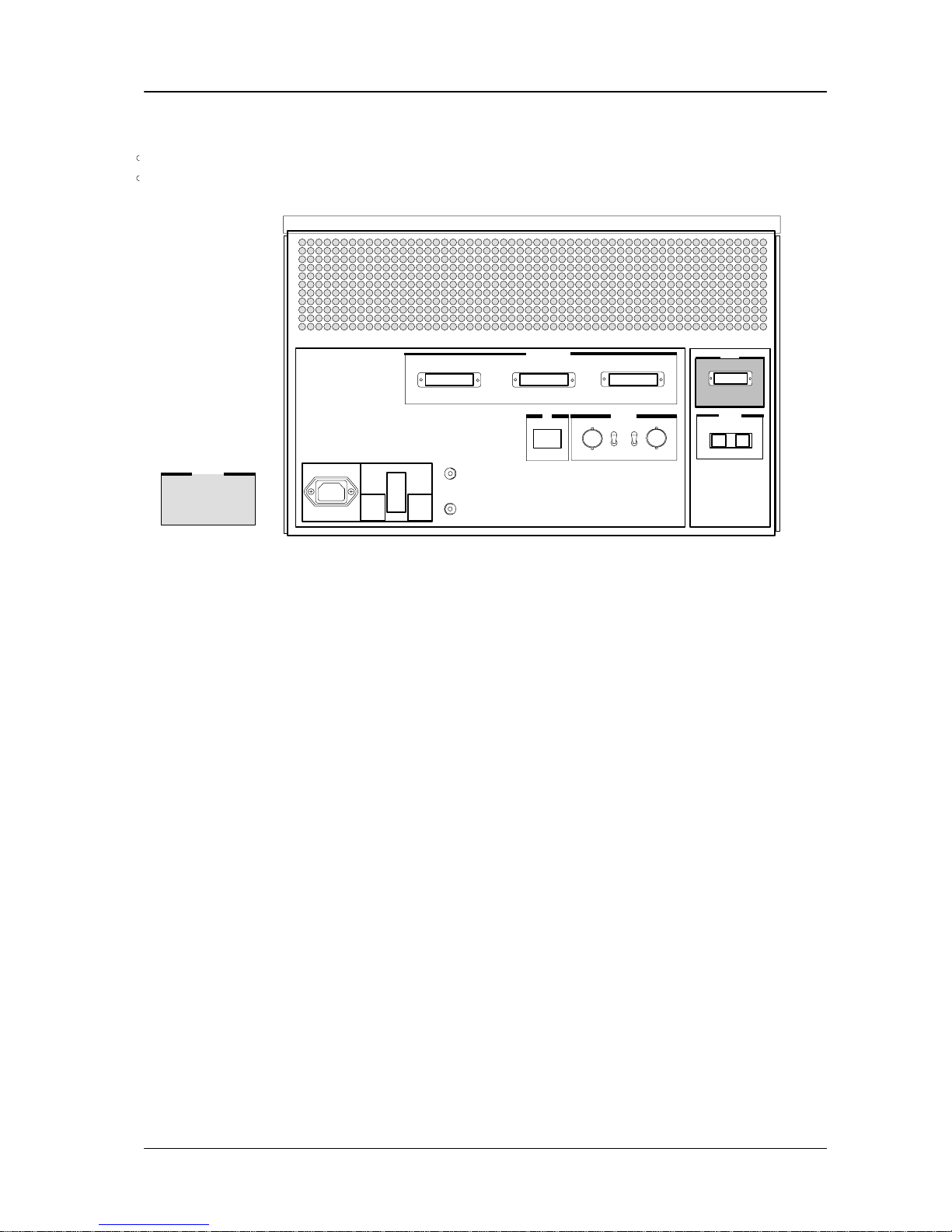
4. ConnectionsDCR 6024/6128/6000
4 – 3
Planning and Installation – Rev. 1 / 7. 2001
4.3 REAR VIEW DDP 6128
CONTROLREC DATAPB DATA
IMCS
AC IN
PE
TO TAPEDECK
OFF
50
OFF
50
IP
POWER
1
0
MONI
HIPPI
TE
OUT
IN
= Option !
Fig. 403: Connections (rear view) DDP 6128
Page 81
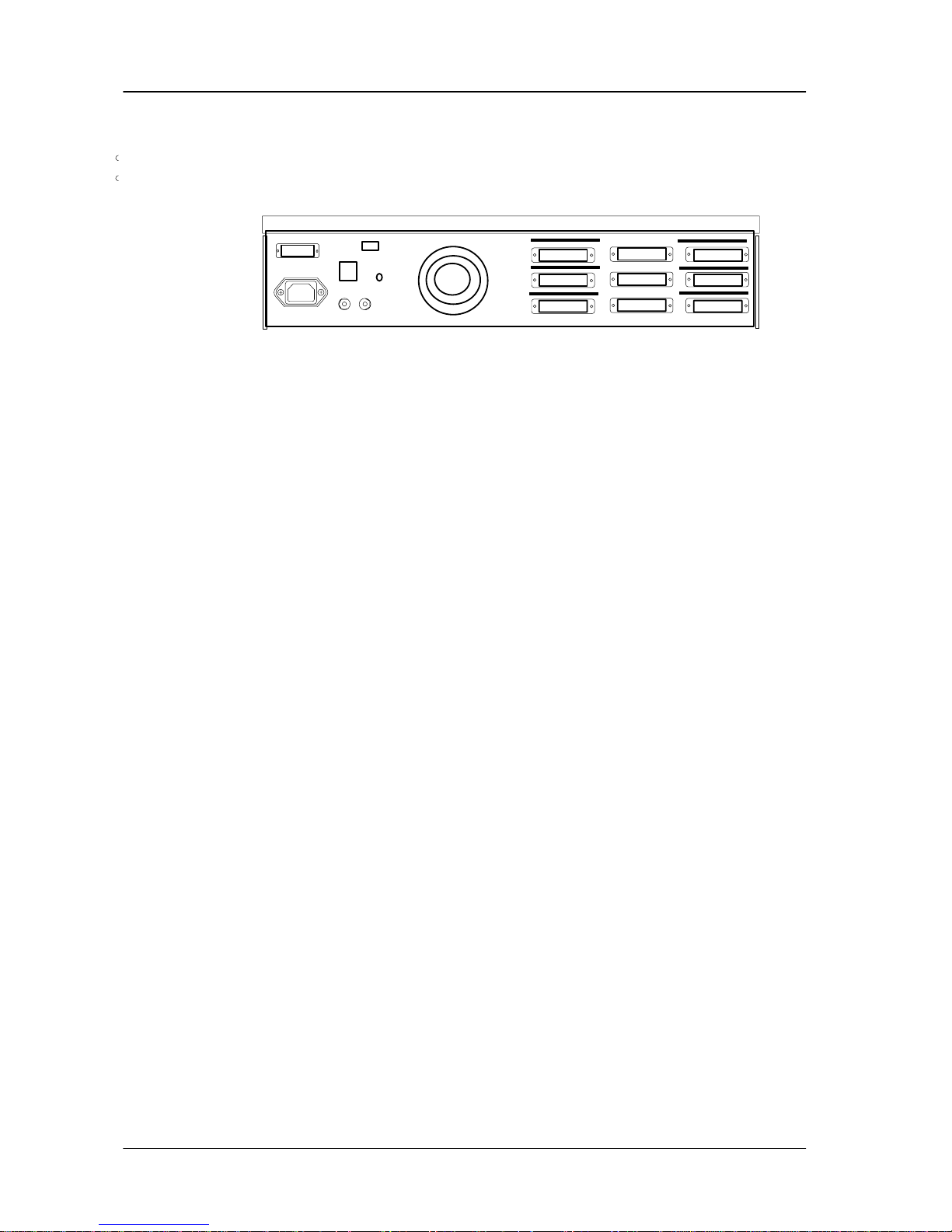
4. Connections DCR 6024/6128/6000
4 – 4
Planning and Installation – Rev. 1 / 7. 2001
4.4 REAR VIEW DWS 6000
CONTROLREC DATAPB DATA
AC IN
TO TAPEDECK
TO DATA PROCESSOR
TO VIDEO PROCESSOR
REMOTE CONTROL
TEST
PUSH SW
PE
TE
Fig. 404: Connections (rear view) DSW 6000
Page 82
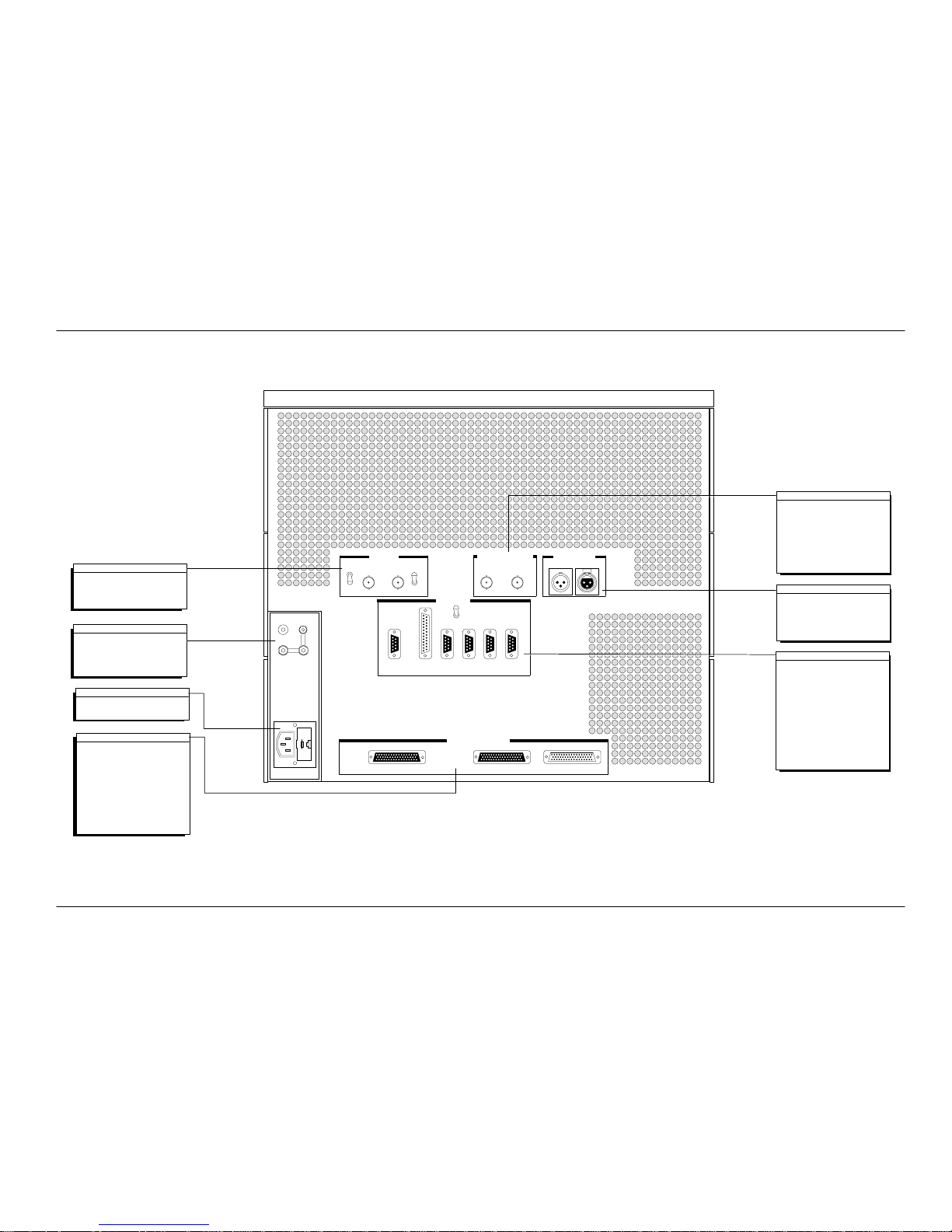
4. ConnectionsDCR 6024/6128/6000
4 – 5
Planning and Installation –Rev. 1 / 7. 2001
4.5 TERMINAL PANEL – TAPEDECK DMS 6000
PE
PB - DATA
IN OUT
REM 3
REM 1
OFF
AudioTEVideo
(PE)
OFF
SIGNAL
RS 232C REM 2
OUTIN
REC - DATA CONTROL
iMCS
TO PROCESSOR
AC IN
50 50
WAVE FORM MONITOR
TIME CODE
TERM
ON
OFF
TRIGGER
REMOTE
FUSE 2x T6.25A
(Rear Panel)
SMPTE TC EBU TECH3097–E
IN
AC POWER 100V to 240V with
grounding connection
Internal machine control system
Digital serial interface for remote
control panel/DCH 6024 auto editing
Grounding connection
TE Audio – Technical Grounding Audio
TE Video – Technical Grounding Video
PE Protective Grounding
SIGNAL
external osciloscope
displaying different RF– and
controltrack–signals
Bandwith > 50 MHz
TRIGGER
synchronize output for external
osciloscope
(PE) – Grounding Jack (for Service)
PLAYBACK – DATA
2 Bit parallel 8 channels ECL-level
RECORD – DATA
2 Bit parallel 8 channels ECL-level
CONTROL
Control signals for
between Tapedeck and Processor
(Timing, Reference signals)
TO PROCESSOR
Output to Processor
Input from Processor
iMCS
GROUNDING
MAINS IN
WAVE FORM MONITOR
TIME CODE
for external TC generator
OUT
from internal TC generator
IEEE 802.3
direct communication
REM 1
REMOTE
serial RS 422 ES-bus interface to
EBU TECH 3245-E
REM 2 IN/OUT
serial RS-422A interface inconformity
for editing systems (e.g. BBE)
REM 3
parallel interface SMPTE recom.
for extern control panel or
General Purpose Interface GPI
RS 232C
serial interface
for Philips service
with EIA standard
Fig. 405: Terminal panel of the Tapedeck DMS 6000
Page 83

4. Connections DCR 6024/6128/6000
4 – 6
Planning and Installation – Rev. 1 / 7. 2001
Page 84
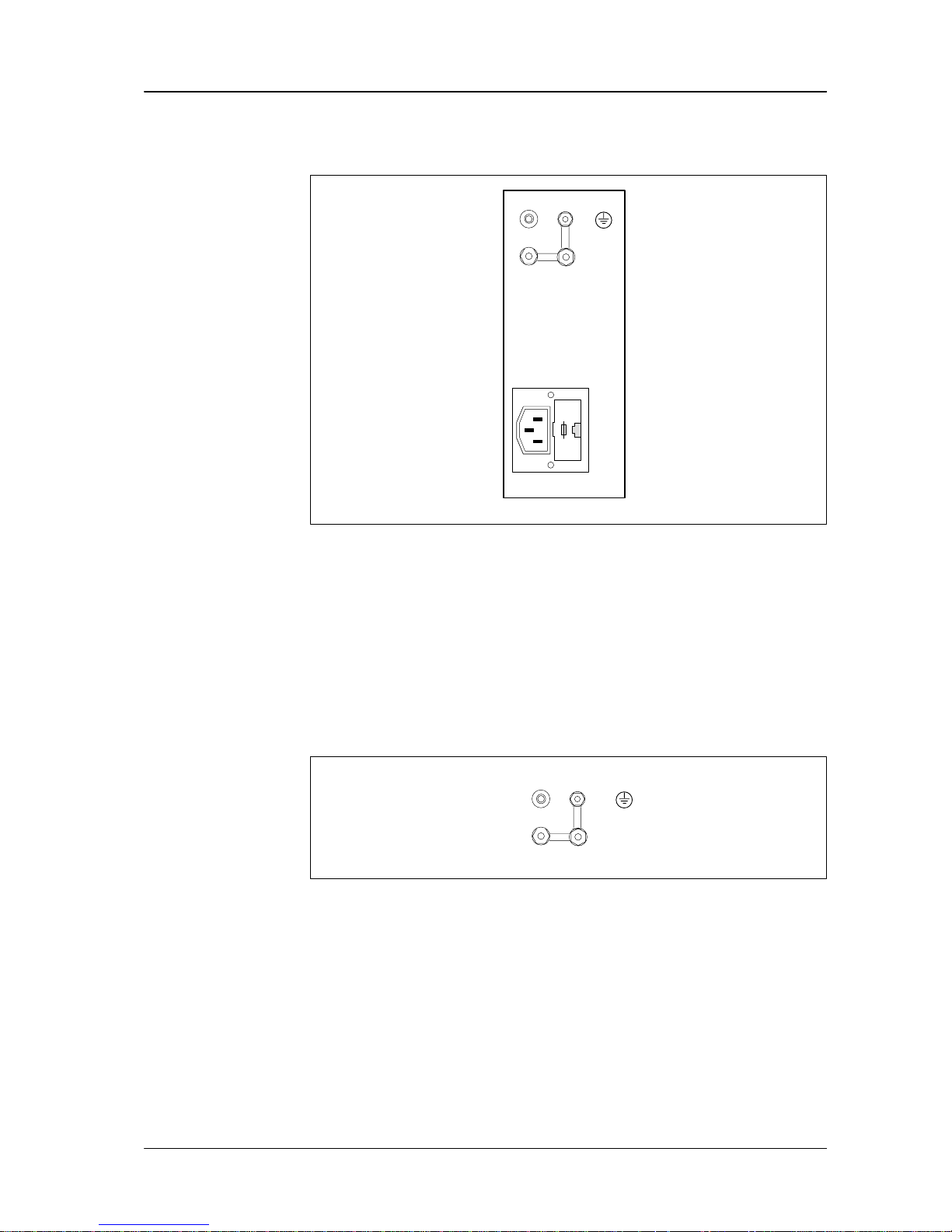
4. ConnetionsDCR 6024/6128/6000
4 – 7
Planning and Installation – Rev . 1 / 7. 2001
4.5.1 AC POWER TERMINAL UNIT BD 5146
GROUNDING
MAINS CONNECTION
INCL. VOLTAGE TEST
AC IN
PE
AudioTEVideo
(PE)
FUSE 2x T 6.25A / 250V
Fig. 406: AC power terminal unit BD 5146 of the Tapedeck
4.5.1.1 GROUNDING
The Tapedeck is to be connected to ground according to VDE 0800/part 2 and/or
the applicable national regulations. The protective conductor must always be connected before the unit is connected to the mains.
The DMS 6000 has separate protective (PE) and functional (TE) grounds. Their
terminals are located at the rear.
PE
AudioTEVideo
(PE)
Fig. 407: Grounding connector of the Tapedeck
The enclosure of the DMS 6000 is always connected to the protective ground (PE)
conductor.
The machine is supplied with the PE and TE grounding terminals bridged.
GROUNDING CONNECTIONS TE AUDIO
TE VIDEO
PE
Page 85

4. Connections DCR 6024/6128/6000
4 – 8
Planning and Installation – Rev. 1 / 7. 2001
In case of non-stationary application the grounding is ensured by the leading
grounding contact of the mains cord. The power cord may only be plugged into a
grounding contact socket outlet.
Do not cancel the protective effect by using an extension cable without a protective
ground conductor nor disable its function in any other way.
The jumpers across the PE and TE terminals must remain installed.
Exception:
When the jumpers are broken, a functional ground must be connected to the TE
terminal screw before the mains cord is connected!
In case of TN-C mains configurations (mains without protective conductor and with
neutralization for protection purposes),
VDE 0100 T.410 (IEC 364–4–41, IEC 304–4–47);
VDE regulation 0100 T.540 (IEC 364–5–54)
or the applicable national regulations must be observed.
Attention!
Any disconnection or break of the protective conductor inside or outside the
video tape recorder may impair the accidental contact protection in case of
a defect.
Grounding can be effected as follows:
Common Grounding: Connect the central protective conductor of the studio with
the PE terminals of the Media Recorder. The jumpers connecting the PE terminals
and the TE terminals have to remain installed.
In this case the cross section of the protective conductor has to correspond to that
of the neutral conductor in the mains cable, however, it must not be less than 2 qmm
(in line with VDE 0800/part 2, table 1).
TE AUDIO
TE VIDEO
PE
Tapedeck
TE A
TE V
PE
Processor
Protective Ground
Audio Ground
Video Ground
Common Studio Ground
Remark: Audio Ground not available in data version
Fig. 408: Connecting protective, video and audio ground at DCR 6024
Grounding in case
of non-stationary
application
TN-C Mains
Studio Grounding
Page 86

4. ConnetionsDCR 6024/6128/6000
4 – 9
Planning and Installation – Rev . 1 / 7. 2001
If necessary (for example in studios having separate protective and functional
grounds), the jumper between PE and TE may be removed. In this case, also the
central functional ground (video and audio ground) must be connected to the
TE terminal screw. It should be designed as functional ground with protective
ground properties and free of noise voltage in line with VDE 0800/part 2.
The cross section of the conductor should meet the requirements mentioned at the
beginning of this section. A low impedance interconnection of the two ground conductors should be made at the central studio terminal or at the ground distributor.
Separated
Grounding
Page 87

4. Connections DCR 6024/6128/6000
4 – 10
Planning and Installation – Rev. 1 / 7. 2001
4.5.1.2 MAINS CONNECTION
AC IN
AC IN
Fuse
FUSE 2x T 6.25A / 250V
Fig. 409: AC Power IN of the Tapedeck
For the mains connection of the DMS 6000 Tapedeck, the mains cord is connected
to the mains connection socket (AC IN). The mains cord is included in the shipment.
Main fuses on connector panel:
2x T6.25 A / 250V slow, UL-listed (valid for the entire voltage range 100 - 240 V).
Caution!
Double-pole or neutral fusing. Risk of electric shock. Grounded circuit conductor (neutral) provided with over-current protection. After operation of the
protective device, parts of the equipment that remain under voltage might
represent a hazard during servicing. Disconnect power before servicing!
The Tapedeck and the Processors include a wide-range power supply unit of 100
- 240V so that no changeover is required for different line voltages.
AC IN
Fuses
Changing of power
supply voltage
Page 88

4. ConnetionsDCR 6024/6128/6000
4 – 1 1
Planning and Installation – Rev . 1 / 7. 2001
4.5.2 PROCESSOR INTERFACE
PLAYBACK DATA RECORD DATA CONTROL
PB - DATA REC - DATA
TO PROCESSOR
CONTROL
Fig. 410: Processor interface
Output to Processor (50 pole D-sub).
2 Bit parallel 8 channels ECL level
Input from Processor (50 pole D-sub).
2 Bit parallel 8 channels ECL level
Control signals (50 pole D-sub) for direct communicating between Tapedeck and
Processor (Timing, Reference signals).
PLAYBACK DATA
RECORD DA TA
CONTROL
Page 89

4. Connections DCR 6024/6128/6000
4 – 12
Planning and Installation – Rev. 1 / 7. 2001
4.5.3 TIMECODE IN/OUT (DTV–MODE)
IN OUT
TIME CODE
Fig. 411: Timecode in/out
For an external connected timecode reader the following signals are available at
the TC-OUT socket:
In play mode:
Timecode signal off tape
In any other mode:
The signal of the internal timecode generator or the signal assigned at the
TC-IN socket.
The selection of the timecode source is effected in the TIMECODE menu (section
4.6.).
Input for external (central) timecode (3 pole XLR)
(SMPTE timecode, wave form according to EBU TECH 3097 E)
Nominal level: 2.2 VPP = 0 dBu
Timecode output (3 pole XLR)
(SMPTE timecode, wave form according to EBU TECH 3097 E)
Nominal level: 2.2 VPP = 0 dBu
IN
OUT
Page 90
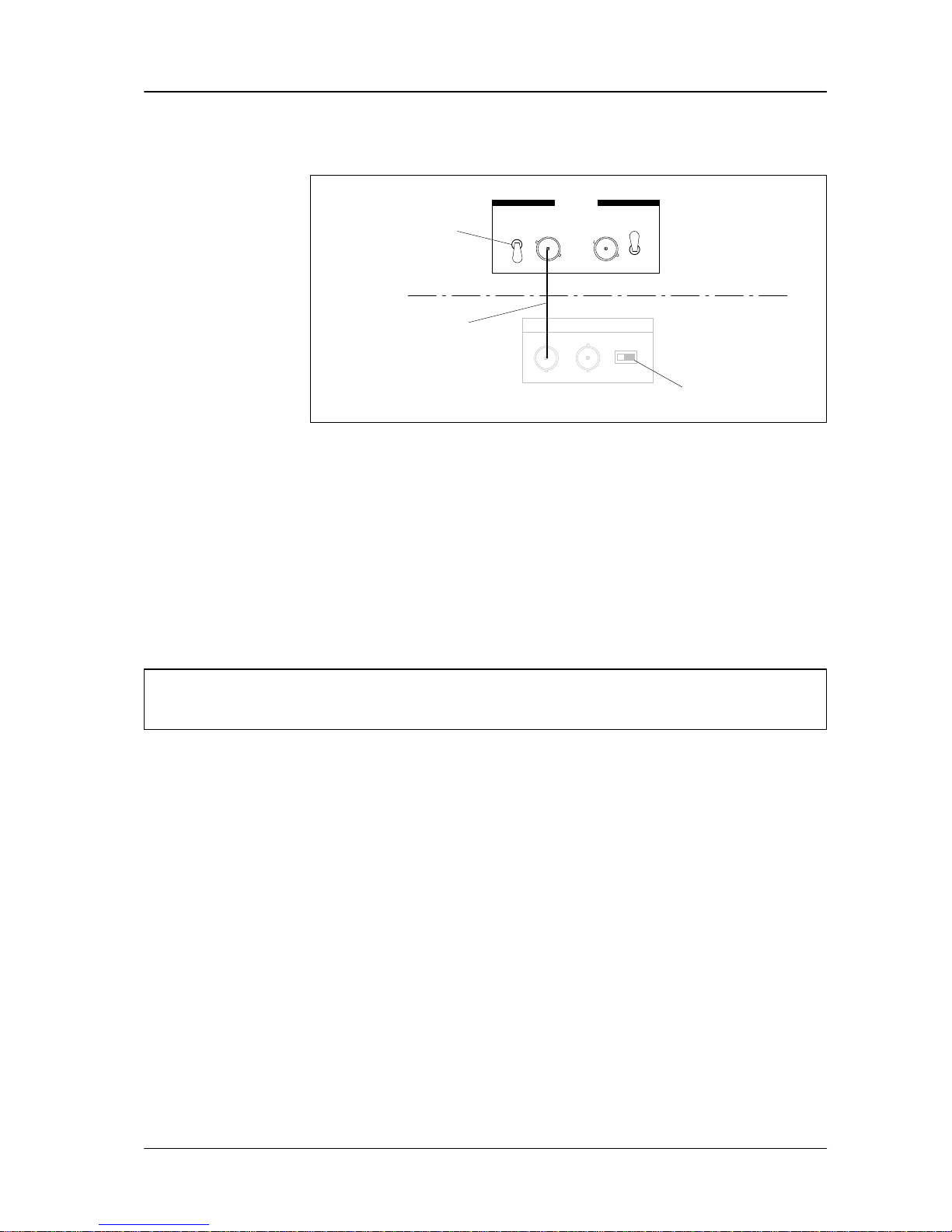
4. ConnetionsDCR 6024/6128/6000
4 – 13
Planning and Installation – Rev . 1 / 7. 2001
4.5.4 IMCS
OFF OFF
iMCS
50 50
Tapedeck
OFF
iMCS
Processor
Switcher ”OFF”
Switcher
Cheapernet cable
Fig. 412: iMCS standard position
IMCS loop input for the Integrated Machine Control System (BNC) for connecting
a D-6 slave recorder when using two DCR 6024 in conjunction with the two-machine editor or for controlling up to 4 DCR 6024 D-6 machines (in preparation).
Note:
This system is based on the Cheapernet System and uses 50 ohm KV 770
cables (also RG 58). Do not terminate with 75 ohm. Terminate only with the
internal 50 ohm terminators which can be switched into circuit with the corresponding switches.
Switching
iMCS
terminations
Important!
Switch that toggle switches ”iMCS” in position ”50 ”, which is not connected
with a cheapernet cable.
Page 91
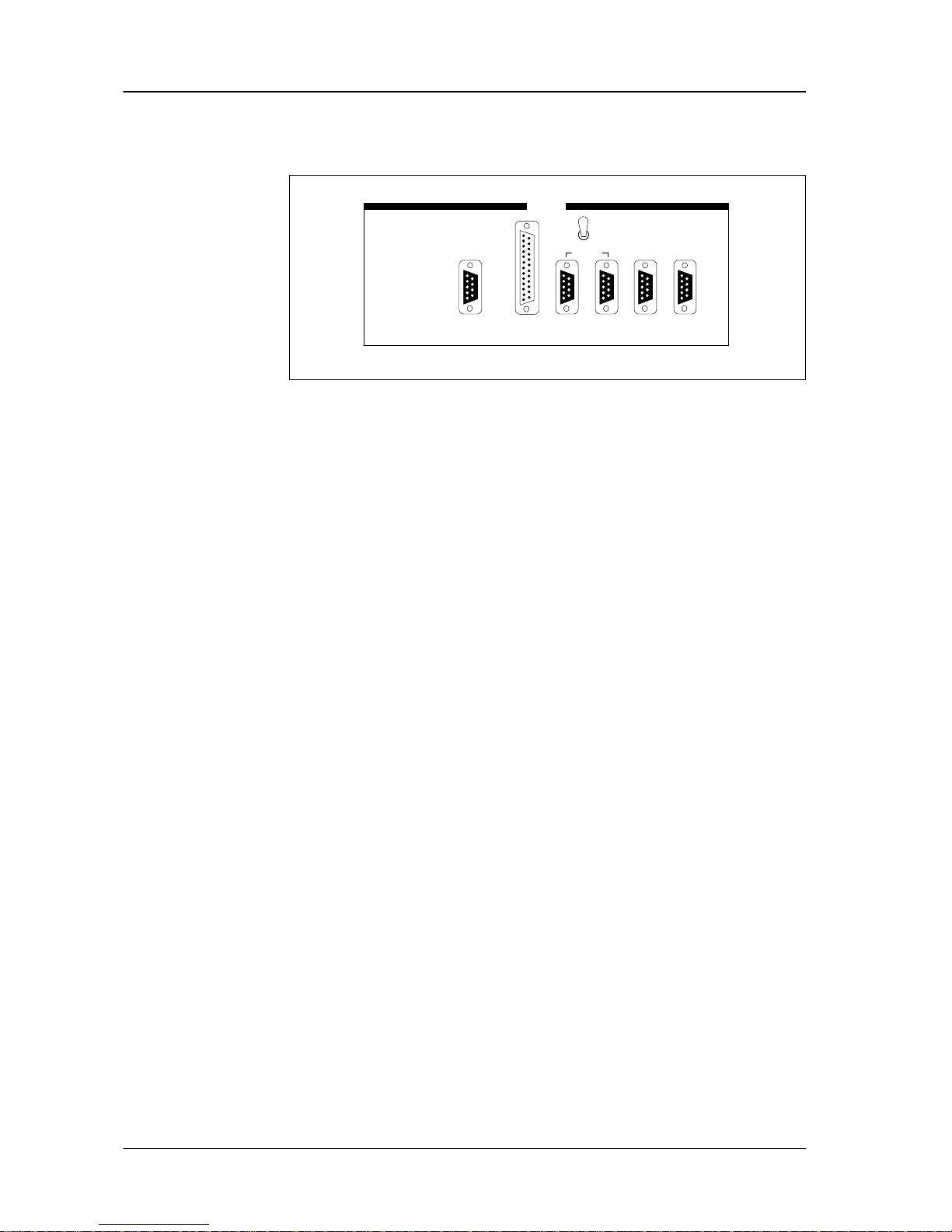
4. Connections DCR 6024/6128/6000
4 – 14
Planning and Installation – Rev. 1 / 7. 2001
4.5.5 REMOTE CONTROL REM 1, REM 2, REM 3, RS 232C
REM 3
REM 1
TERM
RS 232C REM 2
OUTIN
REMOTE
ON
OFF
Fig. 413: Remotes
Remote control connections for REMote mode. The desired interface is selected
in the REMIF submenu (see Operating Instructions, section 4.12.4)
RS 422 loop input (9 pole D-sub)
This input is used to control the machine via the ES-BUS protocol. If the signal is
not looped to a further unit, the input has to be terminated with the switch located
at its side (TERM-ON).
This socket serves (9 pole D-sub) for the control of the DCR 6024 by editing systems (e.g. BBE), graphic systems and film to tape productions via the RS 422A protocol.
This socket serves (9 pole D-sub) for the control of other equipment via the
RS 422A protocol.
Remote interface for Data Switch DSW 6000.
Serial RS 232C interface (9 pole D-sub) for connecting a terminal for Thomson
service.
REM 1
REM 2 IN
REM 2 OUT
REM 3
RS 232C
Page 92

4. ConnetionsDCR 6024/6128/6000
4 – 15
Planning and Installation – Rev . 1 / 7. 2001
4.5.6 WAVEFORM MONITORING
SIGNAL-WFM-TRIGGER
Fig. 414: Waveform monitoring, Trigger
The connector ”SIGNAL-WFM” can be used for output the signals of the control
track, time code track or the envelopes of the 8 RF - signals (oscilloscope bandwidth > 50 MHz).
Connection (BNC) for synchronization of the oscilloscope.
The selection of the output signals is made in the diagnostic menu with window
”Waveform Monitor” (see Operating Instructions, section 4.13.3).
SIGNAL WFM
TRIGGER
Page 93
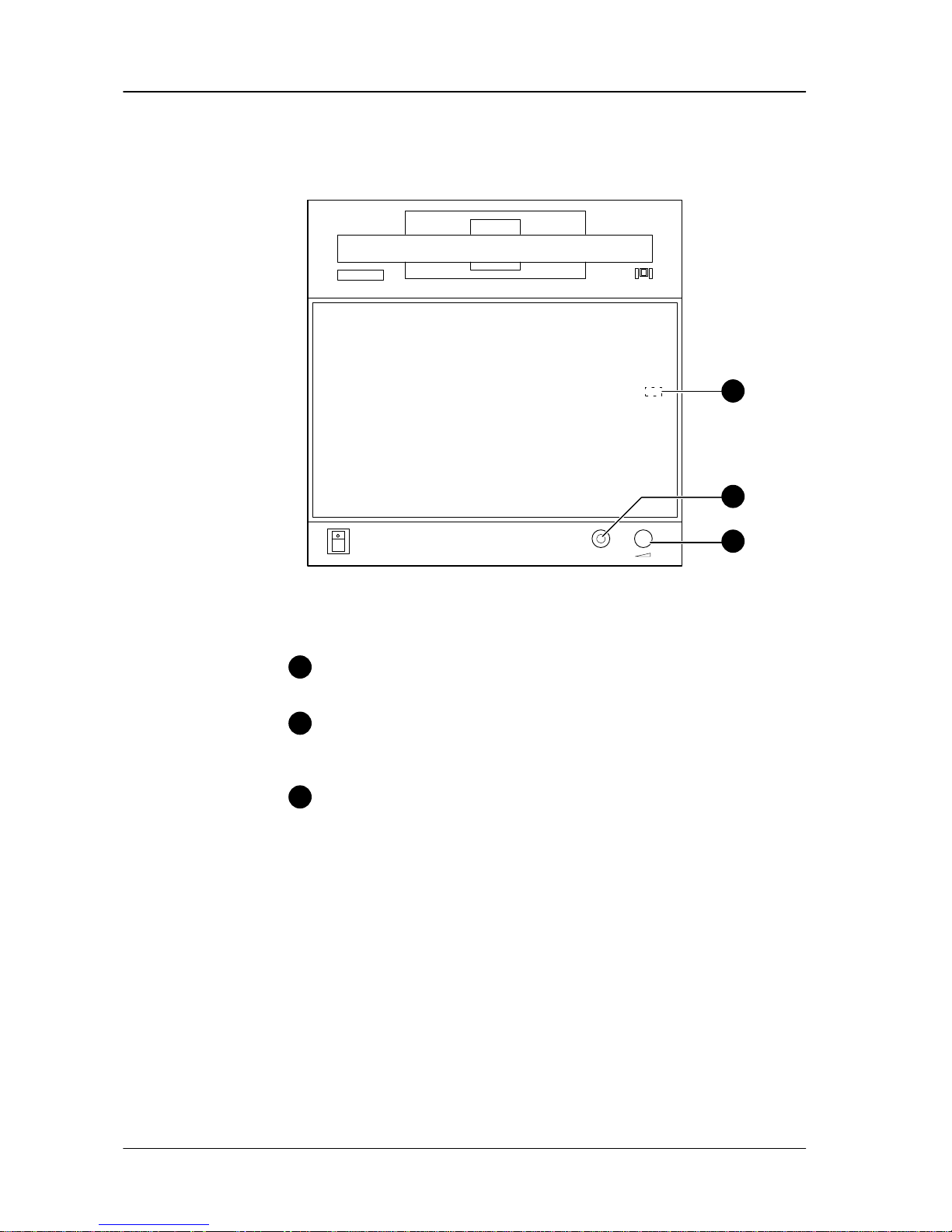
4. Connections DCR 6024/6128/6000
4 – 16
Planning and Installation – Rev. 1 / 7. 2001
4.5.7 CONNECTION CONTROL PANEL AND HEADPHONE WITH VOLUME ADJUSTMENT
POWER
PHONES
DCR 6024
DCR 6024
1
2
3
Fig. 415: Front view of the Tapedeck DMS 6000
1
15 pole subminiature socket to connect the control panel; visible if the front
door is opened.
2
Head phone jack to connect a standard 6.3 mm jack plug (stereo). (for selection of the output signal please refer to section 4.9 ”Audio Levels” Operation
Instruction).
3
Potentiometer to adjust the volume at the head phone jack (2).
Page 94
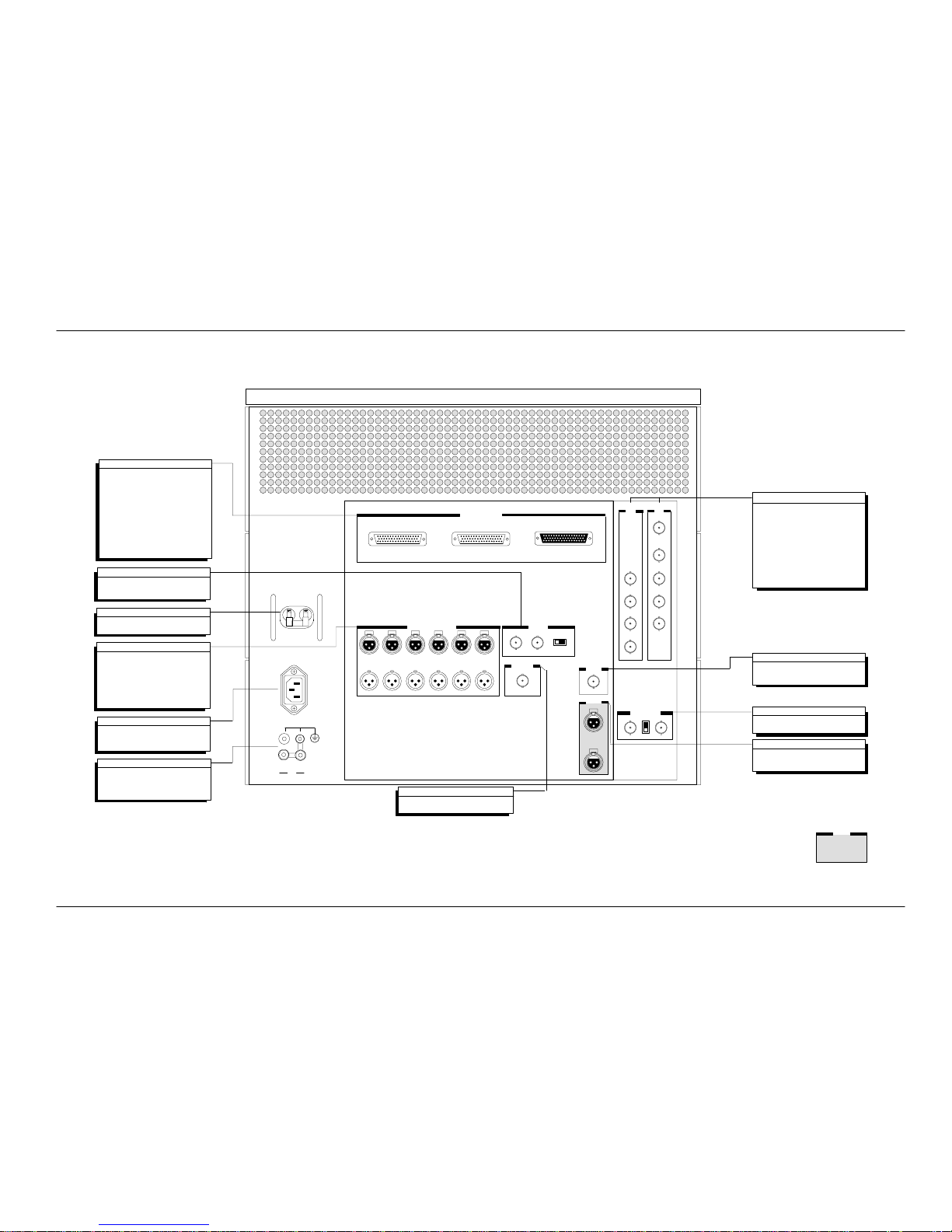
4. ConnectionsDCR 6024/6128/6000
4 – 17
Planning and Installation – Rev. 1 / 7. 2001
4.6 TERMINAL PANEL OF THE PROCESSOR DTV 6024
(Rear Panel)
AC POWER 100V to 240V
with grounding connection
IMCS IEEE 802.3
Digital serial interface for remote
control panel/DCR 6000 auto editing
PLAYBACK – DATA
Input from Tape Deck
2 Bit parallel 8 channels ECL-level
AUDIO DIGITAL I/O
Digital audio serial AES-EBU input
OUT
RECORD – DATA
Output to Tape Deck
2 Bit parallel 8 channels ECL-level
CONTROL
Control signals for direct comminication
between Tapedeck and Processor
(Timing, Reference signals)
BREAKER
15 ampere
Digital audio serial AES-EBU output
IN
Channel 1/2 – 11/12
Channel 1/2 – 11/12
48KHz OUT
48 kHz clock output for sync external
audio units
PLAYBACK REF SYNC
Trilevel sync input
Loop through
NTSC/PAL SYNC OUT
Bilevel 625
AUDIO MONITOR
Analog Audio Monitoring output
L – left output
TO DECK
AC IN
R – right output
TE Audio - Technical Grounding
TE Video - Technical Grounding Video
PE - Proective Grounding
(PE) - Grounding Jack (for Service)
Bilevel 525
sync use with edit contollers
Monitor–
Option
Option
CB–analog chrominance signal
CR–analog chrominance signal
Y–analog luminancs signal
MON–OUT (option)
Digital serial outputs
OUT 1–3
Active loop through
Digital serial input
IN
VIDEO I/O
GROUNDING CONNECTIONS
CONTROLREC DATAPB DATA
75
OFF
IMCS
AUX
R
L
AUDIO DIGITAL I/O
11/129/107/85/63/41/2
OUT
IN
CH
50
AC IN
BREAKER
OFF
TO TAPEDECK
SDI
IN
BUFF
OUT
OUT1
OUT2
OUT3
AUDIO
MONI
MONI OUT
G/Y
R/PR
B/PB
SYNC
NTSC/PAL
SYNC OUT
48 KHz
OUT
REF SYNC
PLAYBACK
= Option !
ATEV
PE
Fig. 416: Terminal panel of the Processor DTV 6024
Page 95

4. Connections DCR 6024/6128/6000
4 – 18
Planning and Installation – Rev. 1 / 7. 2001
Page 96
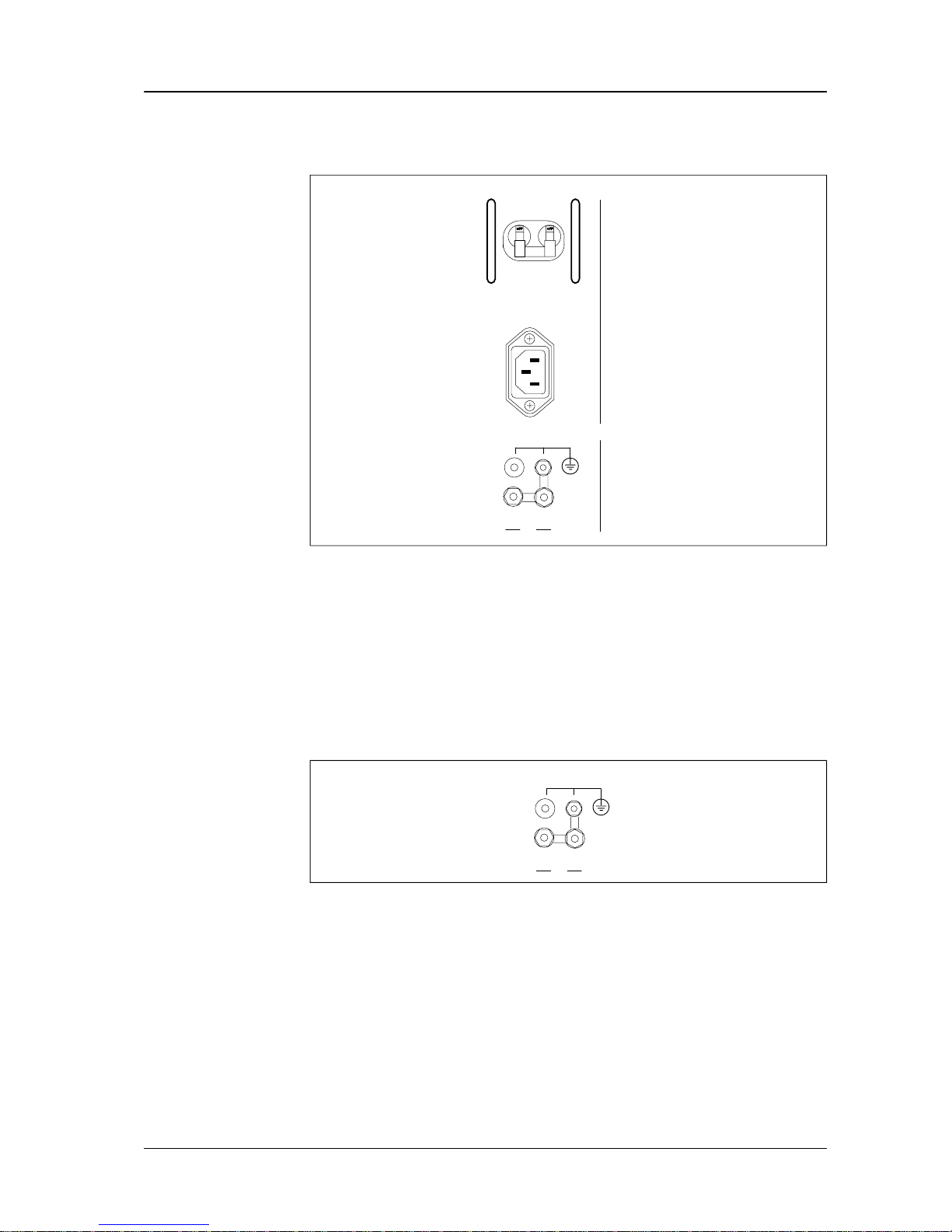
4. ConnectionsDCR 6024/6128/6000
4 – 19
Planning and Installation – Rev. 1 / 7. 2001
4.6.1 AC POWER TERMINAL
GROUNDING
MAINS CONNECTION
AC IN
BREAKER
ATEV
PE
Fig. 417: AC power terminal unit of the Processor
4.6.1.1 GROUNDING
The Processor is to be connected to ground according to VDE 0800/part 2 and/or
the applicable national regulations. The protective conductor must always be connected before the unit is connected to the mains.
The Processor has separate protective (PE) and functional (TE) grounds. Their terminals are located at the rear.
ATEV
PE
Fig. 418: Grounding connector of the Processor
The enclosure of the Processor is always connected to the protective ground (PE)
conductor.
The machine is supplied with the PE and TE grounding terminals bridged.
GROUNDING CONNECTIONS TE A (Audio)
TE V (Video)
PE
Page 97

4. Connections DCR 6024/6128/6000
4 – 20
Planning and Installation – Rev . 1 / 7. 2001
4.6.1.2 MAINS CONNECTION
AC IN
BREAKER
mains connectionAC Power 100V – 240V
Fig. 419: Mains connection of the Processor
For the mains connection of the Processor, the mains cord is connected to the
mains connection socket (AC IN). The mains cord is included in the shipment.
For Processor DTV 6024:
The Processor includes a wide-range power supply unit of 100-240 Volts so that
no changeover is required for different line voltages.
15 Amperes
AC IN
BREAKER
Page 98
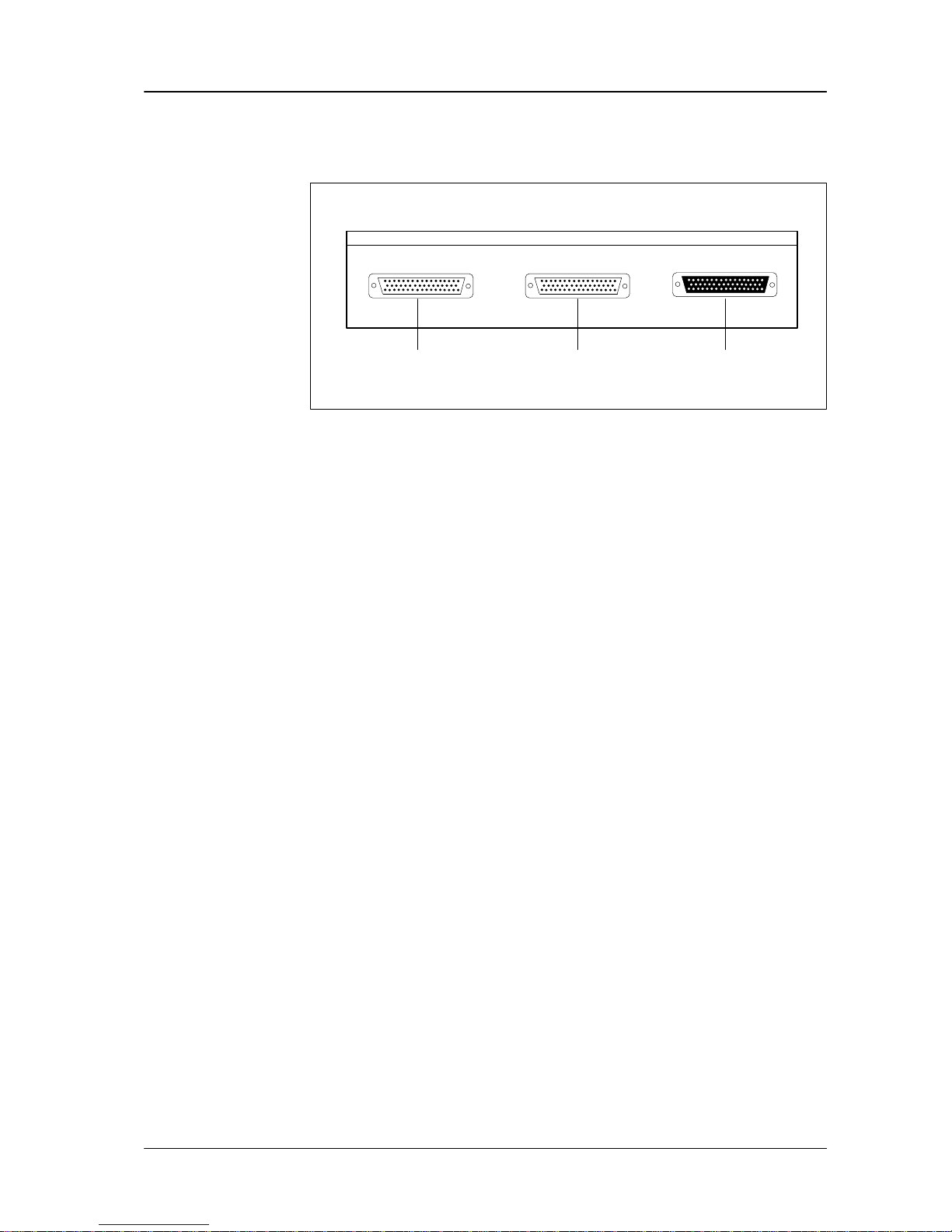
4. ConnectionsDCR 6024/6128/6000
4 – 21
Planning and Installation – Rev. 1 / 7. 2001
4.6.2 TAPEDECK INTERFACE
PLAYBACK DATA RECORD DATA CONTROL
TAPEDECK INTERFACE
CONTROLREC DATAPB DATA
Fig. 420: Tapedeck interface
Input from Tapedeck (50 pole D-sub).
2 Bit parallel 8 channels ECL level
Output to Tapedeck (50 pole D-sub).
2 Bit parallel 8 channels ECL level
Control signals (50 pole D-sub) for direct communication between Tapedeck and
Processor (Timing, Reference signals).
PLAYBACK DATA
RECORD DA TA
CONTROL
Page 99
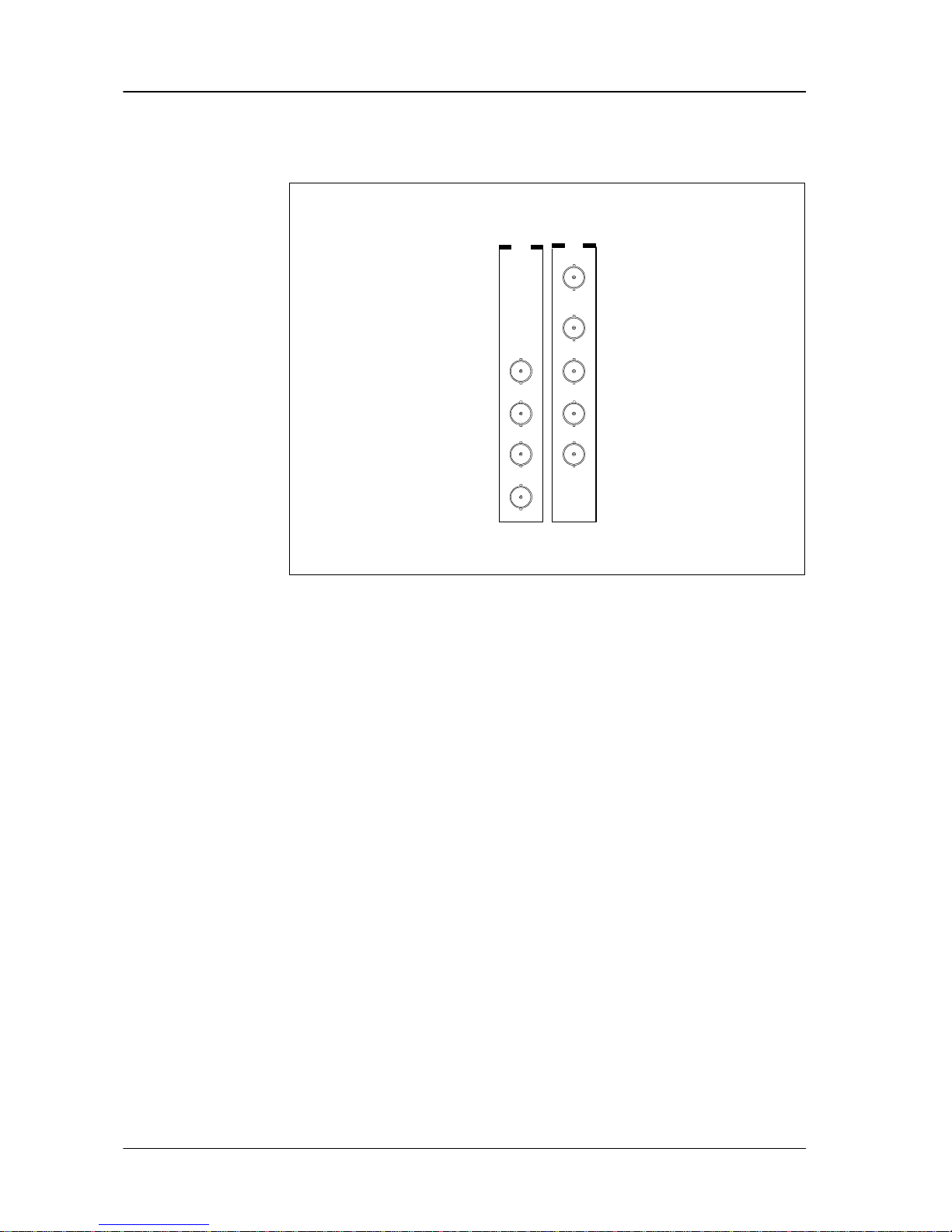
4. Connections DCR 6024/6128/6000
4 – 22
Planning and Installation – Rev . 1 / 7. 2001
4.6.3 VIDEO ANALOG MONITOR OUT
SDI
IN
BUFF
OUT
OUT1
OUT2
OUT3
MONI OUT
G/Y
R/PR
B/PB
SYNC
Fig. 421: Video analog monitoring out
Analog Y / CR / CB or R / G / B signal outputs (Sync On / Off is switchable) (BNC)
Sync output 4 Vpp (BNC)
MON-OUT
Page 100
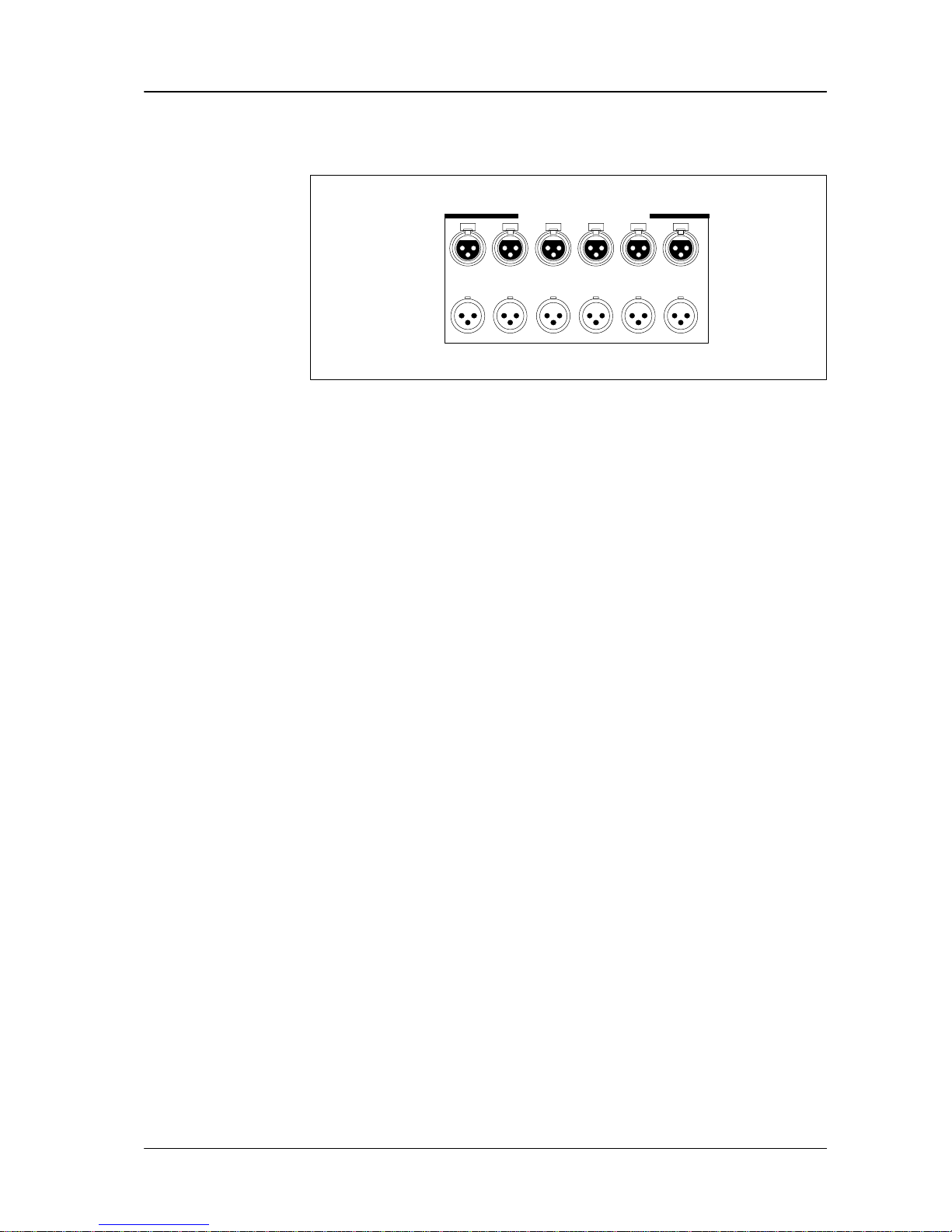
4. ConnectionsDCR 6024/6128/6000
4 – 23
Planning and Installation – Rev. 1 / 7. 2001
4.6.4 AUDIO DIGITAL IN/OUT
AUDIO DIGITAL I/O
11/129/107/85/63/41/2
OUT
IN
CH
Fig. 422: Audio digital in/out
The Processor DTV 6024 has six / five digital audio inputs and outputs.
They are selected in the AUDIO CONFIG menu.
The selection for editing is made in the EDITOR menu.
Digital serial interfaces according to the AES standard
(AES Recommended Practice Draft AES 3-1992, ANSI S 4-40, 1992)
Impedance 1 10 Ω
Level: inputs 0.2 VPP to 10 VPP - outputs 2 VPP to 7 V
PP
Pin assignment: 1 shield - 2 signal - 3 signal
All Inputs are two channel signals. The externally connected audio equipment has
to operate according to the AES/EBU standard. The sampling frequency is 48 kHz,
it must be locked to the video signal. The 48 kHz OUT socket (please refer to section 4.6.6) serves to synchronize an external audio unit.
During cross play modes the output sampling frequency may vary .
IN/OUT
